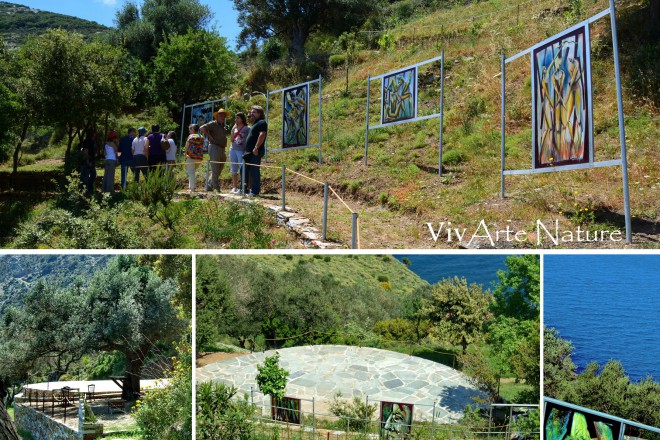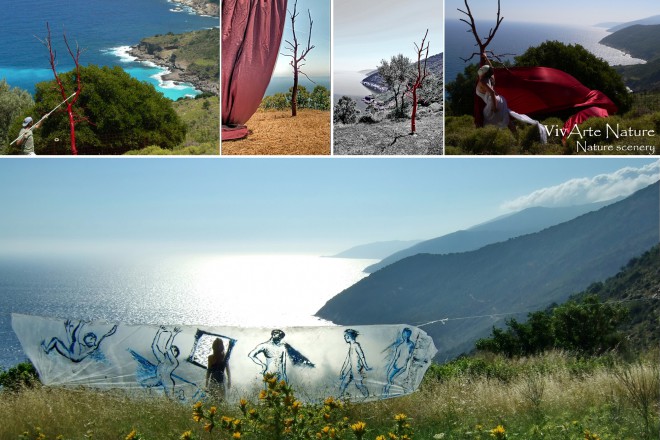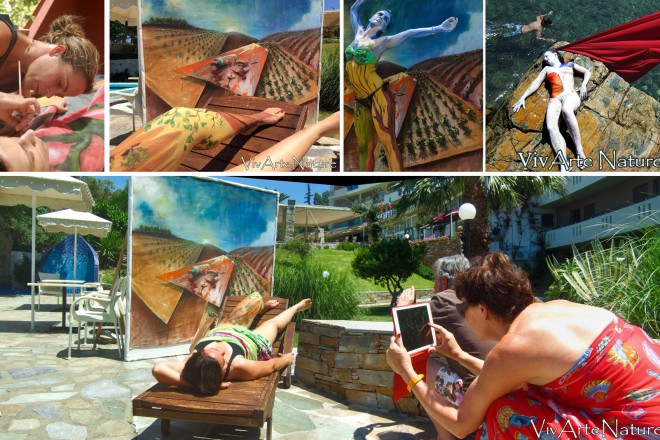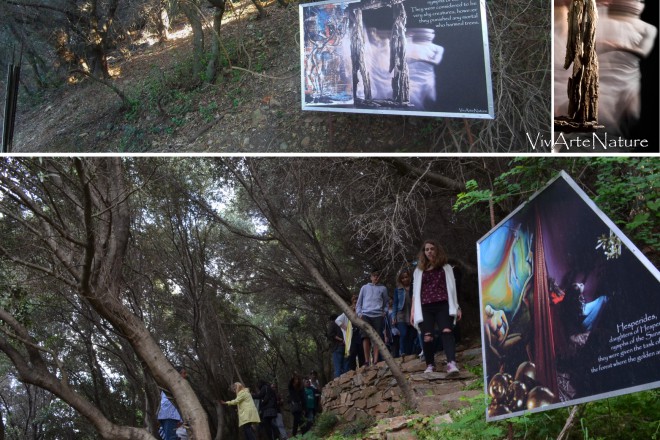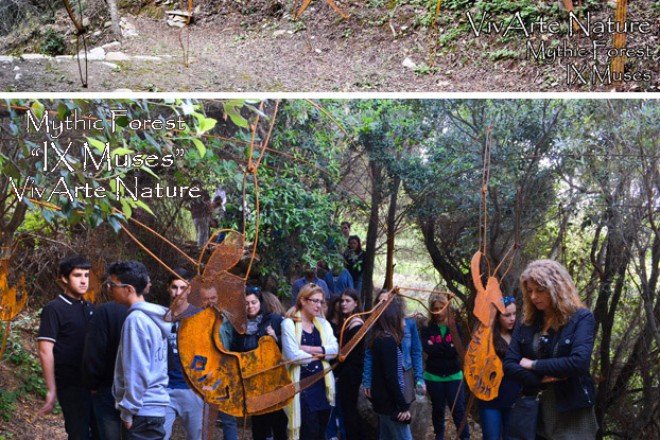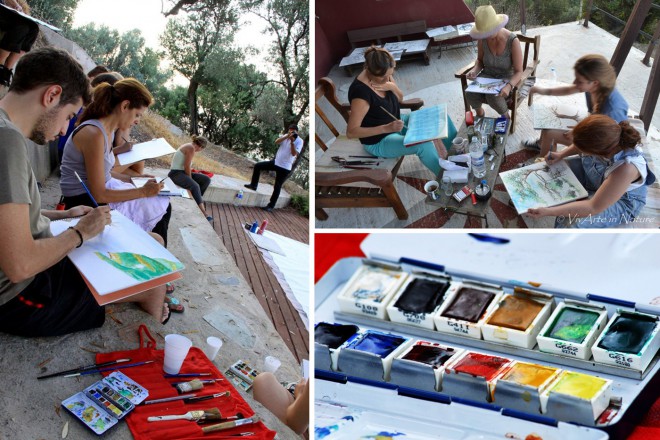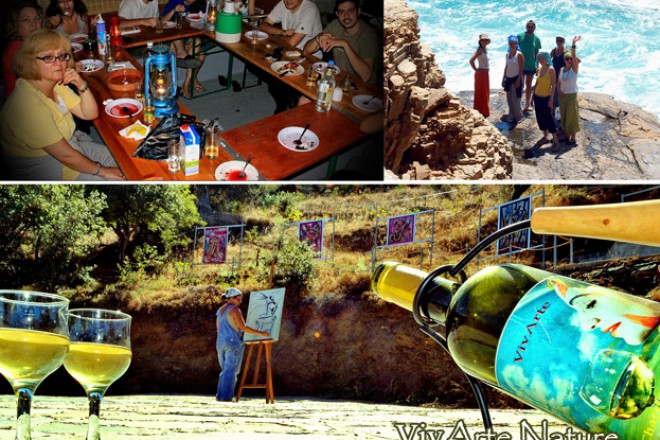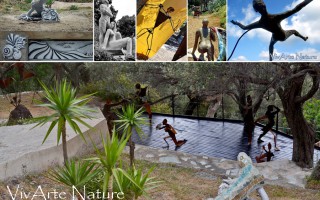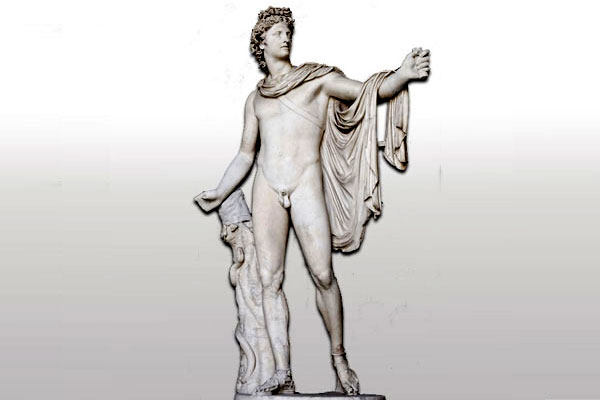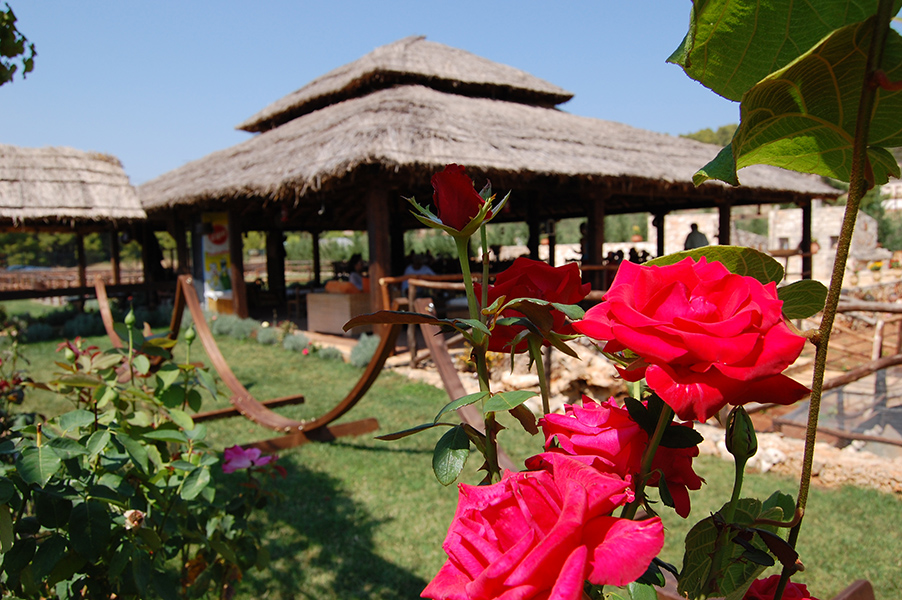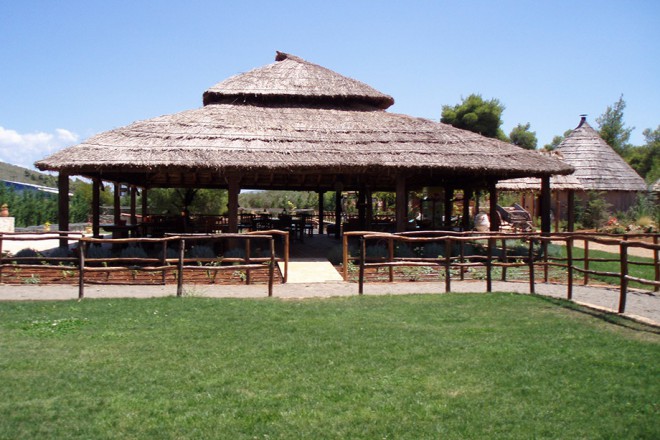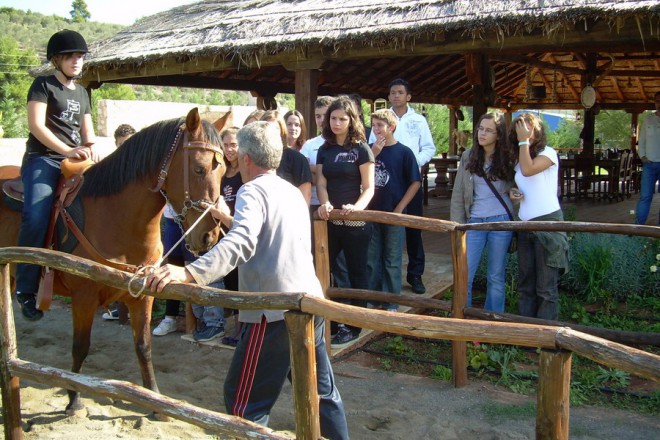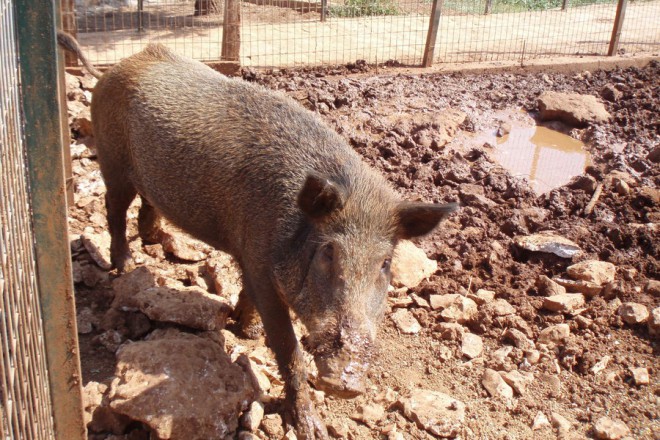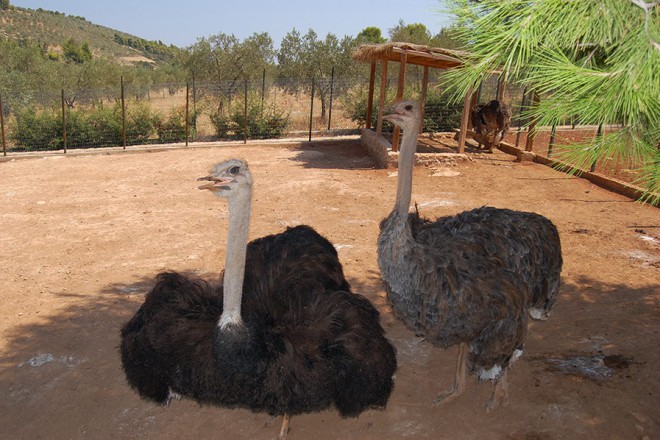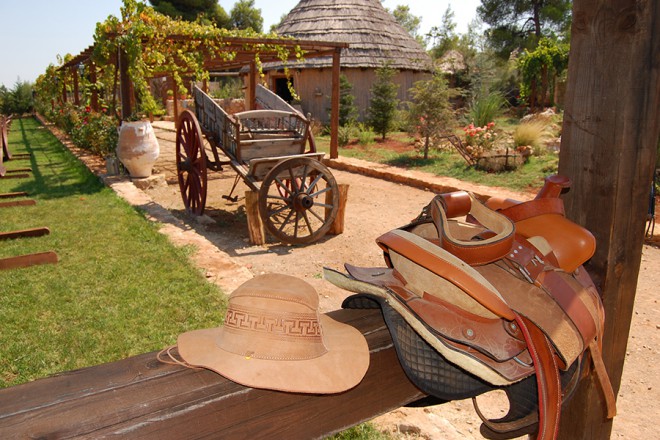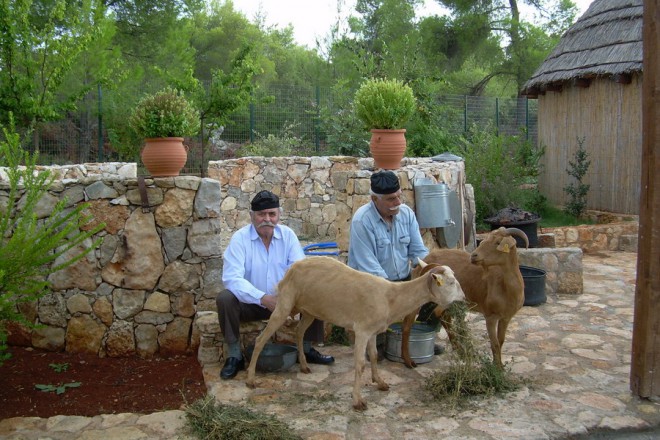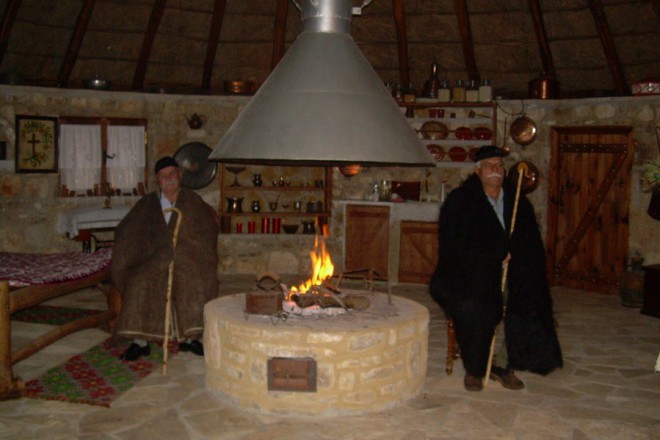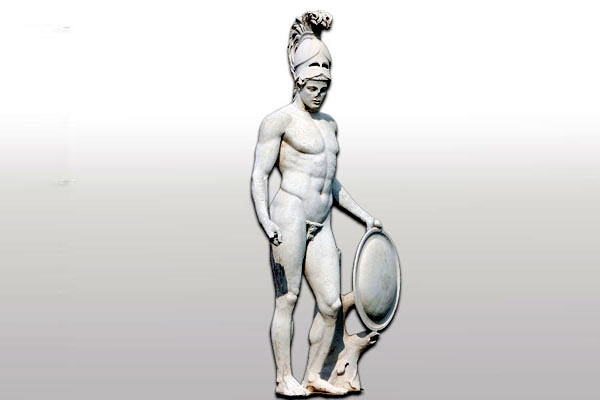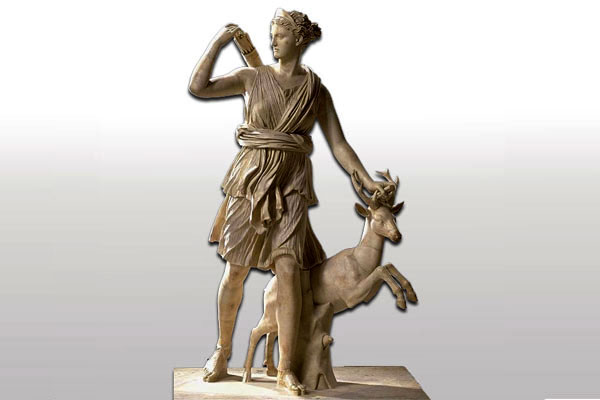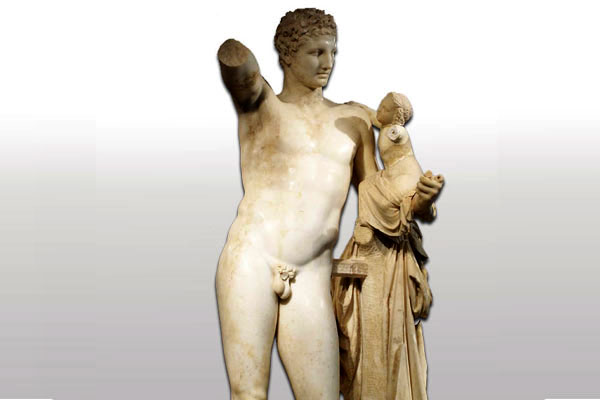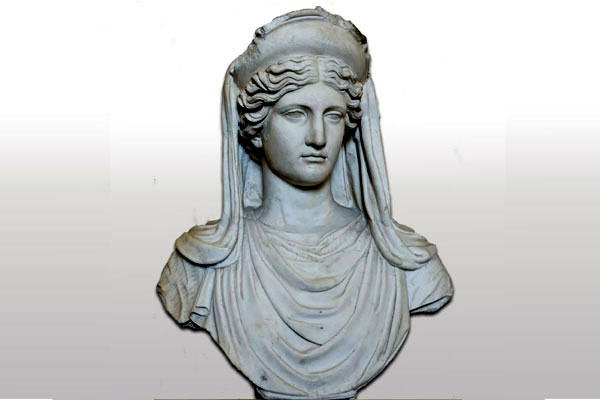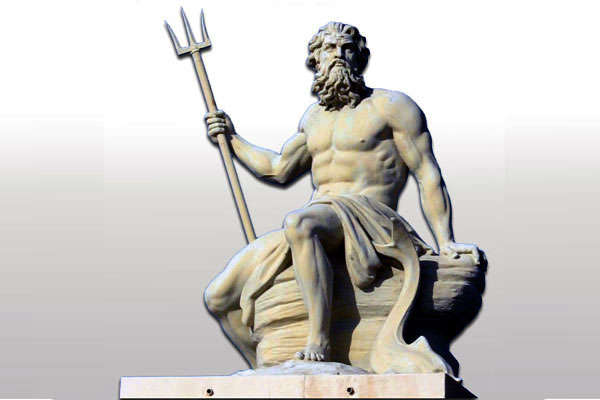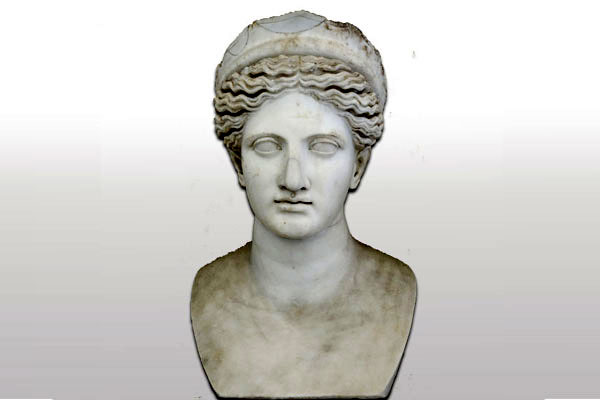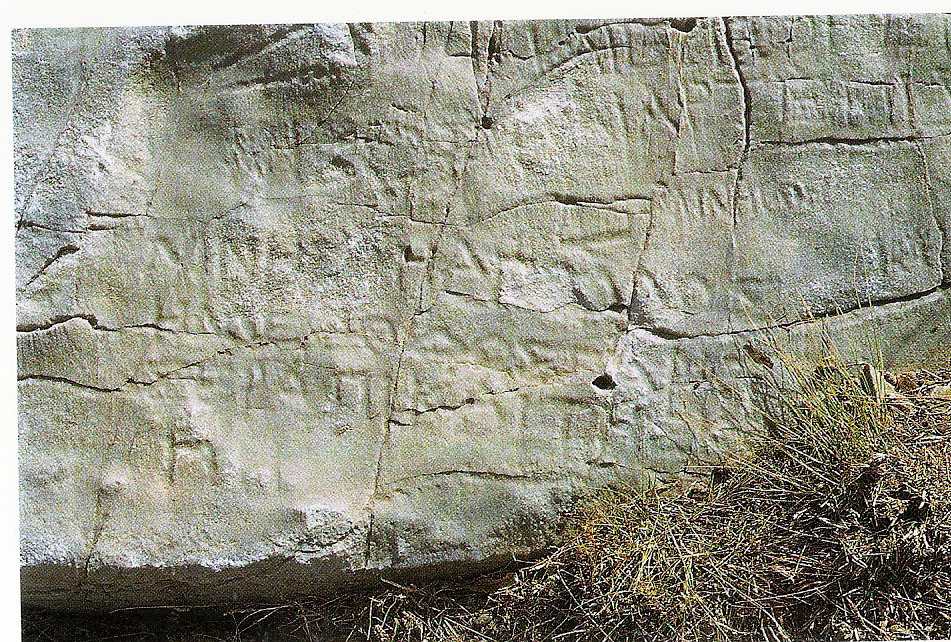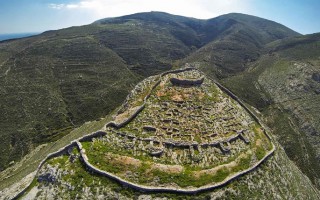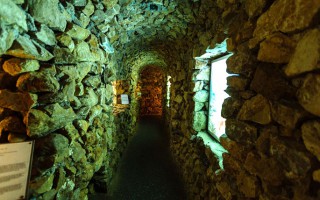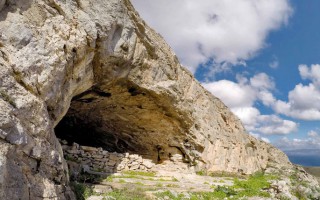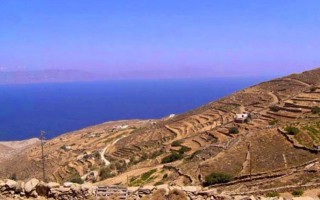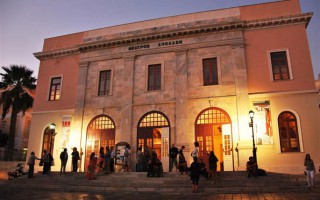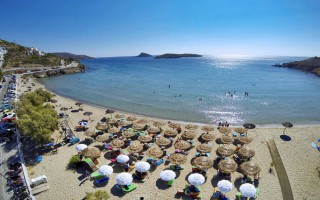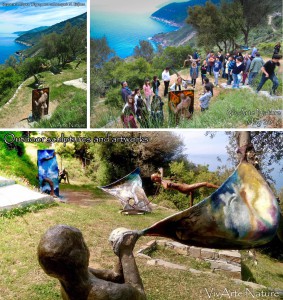 With the triptych nature, art and culture, we propose to our visitors a different intellectual and sensory experience and discover another Greece, Landscape architecture, sculpture, painting, photography and land art… are the tools for a creative Journey in nature guided by culture, “Geopoetry” inspired by the earth.
With the triptych nature, art and culture, we propose to our visitors a different intellectual and sensory experience and discover another Greece, Landscape architecture, sculpture, painting, photography and land art… are the tools for a creative Journey in nature guided by culture, “Geopoetry” inspired by the earth.
A unique spiritual and mental rejuvenation with the Aegean Sea as a background.
Programs:
A – VivArte Nature Site’s visit:
Art in Nature is an alternative choice of an art program. It offers paths and terraces, where different artworks (sculptures, paintings, installation, photography) and proposals are developed, while simultaneously being surrounded by nature. Designed as an open study, you can converse with the artists and learn about their creative process. An intellectual adventure where modern art and ancient myths meet.
B – Walk to discover the “Mythic forest”. A space created by artist and inspired by Greek mythology related to nature. A meeting with the primary gods, nymphs, heroes: Demeter and Persephone, Narcissus and Echo, the Hesperides, Pan Prometheus…
C – Interactive programs, “awakening the senses”
Art and Awareness, (a program open to everyone with or without artistic experience)
Workshop I ”Greece through odors and colors” (painting)
The workshop ”color and greek aroma” lasts 2 hours and takes place in an open place in the “Mythic Forest”. The participants, (with or without artistic experience) with the help of the tutors, create painting work inspired by discrete greek odors. It is a creative game of touring in odors from the greek countryside like basil, lavender, oregano, sage, mint, thyme, eucalyptus, etc. After that, the odors are interpreted through the colors of abstract painting artworks. (The artworks are given as a gift to their creators).
Workshop II “Mythology and Body Art”
The workshop lasts for 3 hours and includes the introduction in greek mythology through the gaze of contemporary art. It is an original and interactive event with body art as the main activity. Painting, photography and body art, make the participants travel in a discrete mythological theme. Then they integrate it in mythological representation picture. After that, follows art photography, with the help of tutors.
Workshop III ”Looking at another Greece” (photography)
The workshop lasts 3 hours. It is about people who love photography and desire to write down their personal journey to another kind of Greece. Travelling with a camera, an awareness study in the observation of the natural landscape of South Evia. A journey into new images. Walks in the Greek nature (flora and fauna) and with the help of the tutors to find and to capture photographically all these things that a visitor cannot discover with a simple walk.
This program will appeal to everyone who desire to:
– get away from the daily routine by combining entertainment with art and creativity
– experience an alternative kind of holiday – a cultural and recreational getaway – by taking part in one of our “VivArte Nature” Art and Awareness Workshops
For artists, the “VivArte Nature” is a place of inspiration and awareness, expression and creation, a place of experimentation and exploring new ideas.
For art-lovers, and for every sensitive person, it is a rare experience of participation in workshops which are aimed at acquaintance and familiarization with the arts, in a unique setting of spiritual and mental rejuvenation.
Website: www.vivartenature.com
Anthidon Estate
- Jan 12,2018
In the Anthidona region, first mentioned by Homer in the Iliad, you will find the ANTHIDON ESTATE. Set amphitheatrically, the estate blends in completely with the uniqueness of the scenery, combining a breathtaking mountainous and sea landscape with α stunning panoramic view of the Evoikos gulf. On our estate, one can enjoy a unique agrotourism experience, clean air and a tranquil environment away... read more
A Haven of Art and Culture in South Evia
- Jun 1,2016
With the triptych nature, art and culture, we propose to our visitors a different intellectual and sensory experience and discover another Greece, Landscape architecture, sculpture, painting, photography and land art… are the tools for a creative Journey in nature guided by culture, “Geopoetry” inspired by the earth. A unique spiritual and mental rejuvenation with the Aegean Sea as a background. Programs: A... read more
Apollo is the eternal golden-haired divine “ephebos” (adolescent), master of the oracles, god of light and music. He is the “paeeon” (healer) who would heal gods and goddesses with his magic touch and powerful light. His cult was divided into his two main aspects: the oracular-therapeutic and the solar-illuminated, different but complementary, as well. On one hand, in his more “Ionic” aspect, he is worshipped as “Phoebus” (he who has Clarity and Light) and “Delios” (he who sees all) centered on Delos and, on the other hand, in his more “Doric” aspect, he is worshipped as the oracle-god, instructor, protector of human beings and, occasionally, punisher, healer and deadly. His two aspects derive from the two major events of his existence: his birth on Delos and his fight with Python for the possession of the oracle of Delphi.
Delos, a sacred land, with a predetermined position in the Greek Mythology, where the two deities of Light were born: Apollo, god of the day-light and Artemis, goddess of the night-light. This sacred island, before becoming “Delos” (visible), was a floating, wandering rock, called “Ortygia” or “Adelos” (invisible). When pregnant Leto was in search of a land in order to give birth, away from Hera’s wrath, Zeus asked his brother Poseidon to help in finding a place somewhere in the sea, for the birth. Poseidon then, took the invisible, floating rock “Adelos”, anchored it with four huge diamond chains and named it “Delos”. Leto, after promising Delos eternal light and prosperity, comes to the sacred lake, not far from the foot of Kythnos Mountain, on the island. She gives birth to Artemis first, all alone, since Hera had forbidden midwife-goddess Eileithyia to be present. Nine days later, with the help of the divine new-born Artemis, she gave birth to Apollo. Leto kept her promise: since that moment, Delos has been bathed by Apollo’s Light. When Apollo was born, Themis, the primordial seer, dripped two drops of nectar, in his mouth and a bit of ambrosia and thus the miracle happened: the divine baby grew immediately, out of the cradle and all the Olympian goddesses, dazzled from his beauty watched him strolling on the island. Apollo rushed on Olympus to take his father’s blessing. Together with the blessings, Zeus’ presents were many: a golden crown -symbol of power- adorned with rubies and emeralds, a lyre which enchanted gods and mortals and a chariot with seven snow-white swans for his travels through the Universe.
The second major event of his life was his fight with dragon Python. Python was the son of Gaea, the “Earth’s gigantic monster”, which spread disaster and death at Delphi. Leto and the Nymphs encouraged Apollo in his struggle with the monster and afterwards, they celebrated his victory by singing hymns and paeans. The etymology of the Apollonian festival “Pythia” and the priestess’s name “Pythia” derives from the dragon’s name “Python”. Apollo was the first Greek god who introduces “Atonement” to the human beings in the form of purification and catharsis -having been purified from the killing of Python, himself- granting, this way, the opportunity of “Forgiveness” and teaching them that even the gods obey the Laws of the Universe.
Apollo delivered “Eunomia” (Rules of Law) to the human race, which he received from Zeus’ hands and made her one with “Armonia” (Pythagorean Harmony) and “Kallos” (beauty). All that is illuminated, is vibrated, as part of the Universe’s Music and Apollo served it with passion, like any other fine art, being the ”Kitharodos” and “Mousagetes” god.
His constant companions were the Nine Muses and his sacred symbols were the laurel, the tripod, the lyre (kithara) and the bow. His sacred animals were the wolf, the swan and the crow (prophetic bird).
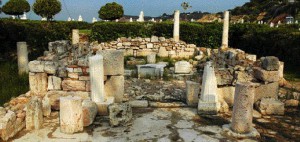 The ancient sources and especially Strabo (1st century BC) were verified by the excavations and the discovery of the temple. Pausanias has also mentioned the establishment of a temple, which was dedicated to Apollo, Artemis and Leto, on the spot where Leto, being chased by infuriated Hera, untied her belt believing it was time to give birth.
The ancient sources and especially Strabo (1st century BC) were verified by the excavations and the discovery of the temple. Pausanias has also mentioned the establishment of a temple, which was dedicated to Apollo, Artemis and Leto, on the spot where Leto, being chased by infuriated Hera, untied her belt believing it was time to give birth.The temple of Apollo Zoster was discovered accidentally, in 1924, by the kids of the Orphan School of Vouliagmeni, while playing in the sand beach. Today, we can see the ruins of the temple at the beach of “Astir Vouliagmeni”. A huge Archaic cistern has been excavated 25 meters away from the temple.
The temple was built in the end of the 6th century BC, in order to become the most important sanctuary of the ancient demos of Alos Aixonidae (modern Voula-Vouliagmeni suburbs). It comprises of a simple cella (Ι0,80 x 6 meters) and a “peristasis” (exterior colonnade) with 6 x 4 unfluted columns. The ruins of a rectangular altar are located in front of the temple.
In the interior of the cella, are the 3 marble pedestals of the cult statues. Two of them bear the inscription “ΗΑΛΑΙΕΙΣ ΑΝΕΘΕΣΑΝ” (the Halians dedicated). The marble throne of the priest has survived together with a marble “table of offerings” which bears an inscription according to which a restoration of the temple took place, during the archonship of Polystratus (4th century BC).
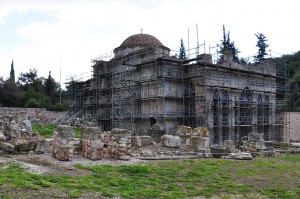 The ruins of the sanctuary of Apollo, at Daphni, are exposed, today, within the fortification wall of the renowned Monastery which is actually the Christian monument of the site’s long, continuous religious tradition. This sanctuary, together with others, on the ancient Sacred Road, was a major religious stop of the ancient Eleusinian Procession which the initiates followed, on their way from Athens to Eleusis. Pausanias visited the sanctuary, after his visit to the “Pythionike” monument, “on his way towards the west”, while following the Sacred Road. He reached the sanctuary of Apollo at Daphni, located “on the southern side of the Sacred Road on his left” as he mentions.
The ruins of the sanctuary of Apollo, at Daphni, are exposed, today, within the fortification wall of the renowned Monastery which is actually the Christian monument of the site’s long, continuous religious tradition. This sanctuary, together with others, on the ancient Sacred Road, was a major religious stop of the ancient Eleusinian Procession which the initiates followed, on their way from Athens to Eleusis. Pausanias visited the sanctuary, after his visit to the “Pythionike” monument, “on his way towards the west”, while following the Sacred Road. He reached the sanctuary of Apollo at Daphni, located “on the southern side of the Sacred Road on his left” as he mentions.The relation of the sanctuary with the Eleusinian Procession (dedicated to Demeter and Kore) explains the co-existence of the cult of Apollo with that of Demeter and Kore, in it. According to an inscription found in the theater of Dionysos, in Athens, Apollo was worshipped in the sanctuary of Daphni as “Daphnephoros”.
It is assumed that there existed a temple dedicated to Apollo and housing the cult statue of both Apollo and goddess Athena. Additionally, the cult statues of Demeter and Kore must have been housed in a separate temple or sheltered stoa, an assumption testified by the great number of fragments of columns scattered around.
The sanctuary was flanked by a peribolos wall, built of large, well cut blocks of stone which were used later for the construction of the Byzantine fortification wall of the Monastery, still visible today. The ruins of the ancient wall can be seen below the Byzantine one, on the northern side of the Monastery peribolos, today. Additionally, the huge, ancient stone threshold of the eastern gate of the Monastery is that of the ancient sanctuary.
 The temple of Apollo “Patroos” (of the ancestors) was built in the middle of the 4th century BC, at the western side of the ancient Agora of Athens, between the Stoa of “Eleftherios” Zeus and the Metroon building. It is a simple structure of a one chamber “sekos” (cella) and a “pronaos” (antae chamber), which was added in the Hellenistic years.
The temple of Apollo “Patroos” (of the ancestors) was built in the middle of the 4th century BC, at the western side of the ancient Agora of Athens, between the Stoa of “Eleftherios” Zeus and the Metroon building. It is a simple structure of a one chamber “sekos” (cella) and a “pronaos” (antae chamber), which was added in the Hellenistic years.A northern lateral-to-the-temple chamber may have served as an Adyton, most probably housing the cult statue of the god or the valuable offerings to him. The temple itself was built over the ruins of an earlier Archaic (6th century BC) one, in front of a pit used for the casting of a bronze cult statue, in the type of a “kouros”.
As for the cult of Apollo, this was revived after the Persian Wars (5th century BC) when emphasis was given to the god’s ancestral aspect, since he was the forefather of the Ionians –the Athenians being Ionian in origin. On the other hand, the “omphalos” stones (Apollo’s stone symbols) that were found in the temple area refer to “Pythios” (of the oracles) Apollo of Delphi and the lateral chamber might indicate a double cult in this small temple.
When Pausanias visited the Agora (around 150 AD), he saw 3 statues in the temple: one of them was a headless statue of Apollo “Kitharodos” (lyre player), in the type of “parendetikos” (dressed up with a feminine outfit), made by Euphranor and the other two were made by the sculptors Leochares and Kalamis.
 The archaeological site of Kolona is located on the NW of the island, near the port and the town of Aegina. The hill has been called “Kolona” (Column) by Venetian sailors for whom the column of the temple was an orientation sign. Kolona site is known for a pre-historic settlement (3rd millenium BC), found underneath the foundations of the temple of Apollo and the temple itself built, in the historic – Archaic years (6th century BC), over the ruins of the pre-historic settlement, at the time of the sanctuary’s prosperity.
The archaeological site of Kolona is located on the NW of the island, near the port and the town of Aegina. The hill has been called “Kolona” (Column) by Venetian sailors for whom the column of the temple was an orientation sign. Kolona site is known for a pre-historic settlement (3rd millenium BC), found underneath the foundations of the temple of Apollo and the temple itself built, in the historic – Archaic years (6th century BC), over the ruins of the pre-historic settlement, at the time of the sanctuary’s prosperity.The Archaic temple of Apollo stands out, on a high level, within the ruins of the sanctuary. It is a Doric, peripteral temple with 11 x 6 columns, including a “pronaos” (antae chamber) and an “opisthodomos” (rear chamber). Today, the surviving ruins of the temple comprise of a monolithic column of the opisthodomos and the lowest part of the foundations. The altar is located on the eastern side of the temple while a small temple of Artemis has been revealed on the SE corner of the acropolis and a propylon at the south. Priests’ houses and two small rectangular structures are located further to the south. The walls of the sanctuary, which have survived, date from different eras, i.e. Archaic, Hellenistic and Roman.
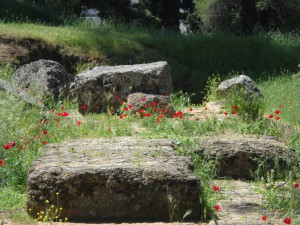 Ptoon Mountain (720 meters of altitude) is located in the region of Boeotia, 3 kilometers east of Akraiphnion town. According to the legend, Apollo had two sons from Zeuxippe, called Ptoos and Akraipheas. His first son gave his name to the mountain and his second one to the town. There is another legend that connects the local hero Ptoos, son of Athamas and Themisto, with Apollo and their successive cults in the area: Ptoos’ cult, being the earlier in the area and Apollo’s cult being the newer, preserving though the epithet “Ptoos” in honor of the hero, thus “Apollo Ptoos
Ptoon Mountain (720 meters of altitude) is located in the region of Boeotia, 3 kilometers east of Akraiphnion town. According to the legend, Apollo had two sons from Zeuxippe, called Ptoos and Akraipheas. His first son gave his name to the mountain and his second one to the town. There is another legend that connects the local hero Ptoos, son of Athamas and Themisto, with Apollo and their successive cults in the area: Ptoos’ cult, being the earlier in the area and Apollo’s cult being the newer, preserving though the epithet “Ptoos” in honor of the hero, thus “Apollo PtoosHere, below a rock outcrop of Mountain Ptoon, at a height of 225 meters, in a region called “Perdikovryse” and next to the chapel of Ayia Paraskevi, the temple of Apollo was built in the 4th century BC. The sanctuary comprised of the temple, the “mantic” (oracle) cave and the temple of “Pronaia” Athena. The temple of Athena was a symbolic small (4,30 x 6,70 meters) copy of the temple of Athena Pronaia of Delphi and was located east of Apollo’s temple.
The Doric temple of Apollo, at the highest part of the sanctuary, was built in the age of Kassander (316 BC) of Macedonia and depended on Thebes. Very few fragments have survived from the earlier temple which was built on the same spot. A plethora of Archaic bronze offerings, like tripods, figurines and clay vessels have been brought to light. Their dedicatory function has been testified by inscriptions.
A “cave-manteion” (cave-oracle) of the god functioned together with the temple, characterized as “polyphonon” (polyphonic) since oracular answers would be given in different languages. The cave comprised of a vaulted structure, in a depth of 5-6 meters, thus offering privacy. It functioned as an oracle for many centuries –one of the 6 oracles of Boeotia. The other 5 oracles were those of Trofonios in Lebadeia, of Thebes, of Amphiaraos, of Tegyra and of Abae. The cave was located south from the temple of Apollo and was supplied with the water of a nearby spring via a clay pipe. On the lower levels of the sanctuary, there were stoas, “xenons” (hostels), a cistern and the oracular spring.
The inscriptions testify that the oracle of Ptoon was a spiritual center, protected by the confederacy of Boeotian cities, the so-called “Koinon of Boeotians”. In the end of the 4th century BC, the “Koinon” included the cities Akraiphia, Anthedon, Chalkis, Koroneia, Aliartos, Lebadeia, Orchomenos, Oropos, Plataies, Tanagra, Thebes, Thespies and Thisbe. A little later, the cities of Yettos, Chaeronea and Kopes were added. The Koinon was governed by the representatives of the Boeotian cities and an executive board which comprised of the archons, the delegates, the eponymous archon and a secretary.
The “Ptoia” festival was a spiritual contest, held every 5th year. An inscription of the 1st century BC informs us that there were contests for trumpeters, pronouncers, rhapsodists, epic poetry, athletics, and lyre playing. These contests were held in the nearby theater, most probably located in the northern parts of the sanctuary. The theater comprised of wooden seats around a circular orchestra. The altar “thymeli” was, as in all theaters, in the center of the orchestra.
 Bassae is located south of the Arcadian town of Andritsaina, on the western slopes of Kotylion Mountain and near the ancient city of Phigaleia. The mountain is scored with “vassai” (ravines), which give the place its name. In this bare, rocky landscape, 1.131 metres above sea level, the people of Phigaleia founded a sanctuary in honour of Apollo. A sacred road connected the sanctuary with the city, nearly thirteen kilometres away. The sanctuary was dominated by one of the most imposing monuments of ancient Greece: the temple of Apollo Epikourios.
Bassae is located south of the Arcadian town of Andritsaina, on the western slopes of Kotylion Mountain and near the ancient city of Phigaleia. The mountain is scored with “vassai” (ravines), which give the place its name. In this bare, rocky landscape, 1.131 metres above sea level, the people of Phigaleia founded a sanctuary in honour of Apollo. A sacred road connected the sanctuary with the city, nearly thirteen kilometres away. The sanctuary was dominated by one of the most imposing monuments of ancient Greece: the temple of Apollo Epikourios.The temple of Apollo Epikourios, one of the most important and most imposing temples of antiquity, stands within the bare and rocky landscape of Bassae. It is unique in the history of ancient Greek architecture because it combines a variety of novel ideas both in its external appearance and in its internal arrangements. Indeed, Pausanias considered it to be among the finest temples of the Peloponnese in terms of sheer beauty and harmony, second only to that of Tegea (8, 41, 8). The building is dated in 420-400 BC and is believed to be the work of Iktinos, who succeeded in combining several Archaic, conservative Arcadian features with the features of the new Classical style. The surviving temple is not the first one to have been constructed on the site. The earliest temple of Apollo erected in the late 7th century BC, possibly at the same location, was rebuilt at least twice in approximately 600 and 500 BC (Archaic era). Many architectural features from these two phases survive, including a large terracotta “acroterion” (top roof tile) with ornate painted decoration, roof-tiles and antefixes.
A Doric frieze of undecorated metopes and triglyphs ran along the outer facades of the upper part of the temple. Only the inner metopes of the short sides were decorated: those on the “pronaos” (antae chamber) had depictions of Apollo’s return to Olympus and those on the “opisthodomos” (rear chamber) contained the Capture of the daughters of the Messenian king Leukippos by the Dioskouroi. The pediments may have been undecorated. The temple’s main decorative feature was the marble Ionic frieze supported by the Ionic half-columns within the cella. This frieze was 31 meters long and consisted of 23 marble slabs, of which 12 depicted battles between Greeks and Amazons and the remaining 11 ones showed battles between Lapiths and Centaurs. The frieze was unearthed by foreign antiquaries in 1812 and sold to the British Museum in 1815. It may have been the work of sculptor Paionios, who had also executed the celebrated statue of Nike at Olympia.
The temple remained in use into the Hellenistic and Roman periods, its roof being repaired several times.
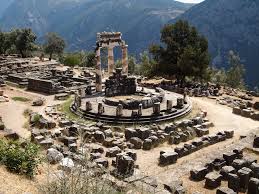 At the foot of Parnassos Mountain, within the angle formed by the twin rocks of the Phaedriades, the Pan-Hellenic sanctuary and oracle of Delphi lies “on the center of the world”. The two eagles of Zeus met here, while flying from the ends of the universe, in search of the “omphalos” (navel-center) of the world. The sanctuary of Delphi, set within a most spectacular landscape, was for many centuries the cultural and religious centre and symbol of unity for the Hellenic world.
At the foot of Parnassos Mountain, within the angle formed by the twin rocks of the Phaedriades, the Pan-Hellenic sanctuary and oracle of Delphi lies “on the center of the world”. The two eagles of Zeus met here, while flying from the ends of the universe, in search of the “omphalos” (navel-center) of the world. The sanctuary of Delphi, set within a most spectacular landscape, was for many centuries the cultural and religious centre and symbol of unity for the Hellenic world.The temple of Apollo dominates the sacred temenos with its central position. This is where the statues and other offerings to the god were kept, and where the cult rituals, including that of divination, took place. Also, here was the “chresmographeion” (archive), which contained the lists of victors of the Pythian Games and which was destroyed in 373 BC.
According to the legend, the first temple of Apollo was a hut made of laurel branches, the second of beeswax and feathers and the third of bronze, while the fourth was built by the legendary architects Trofonios and Agamedes who were inspired by Apollo. This was probably the stone temple that was destroyed, by fire, in the 6th century BC (548 BC).
The fifth temple, which replaced the burnt one, was built with contributions of both Greeks and non-Greeks and was completed in the end of the 6th century BC (around 510 BC), by the Alkmaeonidae family of Athens. It was a Doric “peristyle” (surrounded by 6 x 15 columns) temple, with a marble façade and decorated with exquisite sculptures. The famous sculptor Antenor created the two pediments. The east pediment depicted Apollo’s Epiphany, himself being depicted in the center with his sister Artemis and his mother Leto, on a chariot –with the pediment corners being filled with male and female figures. Of the west pediment, which depicted the Gigantomachy, only the figures of Athena, a fallen giant, a male figure and two horses have survived. This temple was destroyed by the destructive earthquake of 373 BC. The priests received contributions, again, for a new one.
The 6th new temple, whose ruins are seen in situ, was completed in 330 BC. It is an imposing Doric temple built by the architects Spintharos from Corinth, Xenodoros and Agathon. It has the same plan and roughly the same dimensions as its predecessor, with 6 x 15 columns and both “prodomos” (antae-chamber) and “opisthodomos” (rear chamber) in antis. The “sekos” (cella) was divided into three naves by two colonnades of eight Ionic columns each. The divination ceremony took place in the inner shrine, called Adyton, an underground chamber where only the priests interpreting Pythia’s words had access. The pedimental sculptures were made of Parian marble by the Athenian sculptors Praxias and Androsthenes. The east pediment depicted Apollo and the Muses, and the west one Dionysus and the Maenads. Little is known of the arrangement of the temple’s interior. It has been testified by ancient writers that the walls of the pronaos were inscribed with sayings of the seven sages, such as “know thyself”, “everything in moderation” and the letter E. There was a bronze effigy of Homer and an altar of Poseidon, and, in the adyton, a statue of Apollo and the omphalos. The temple has been partially restored. Fragments of the pedimental sculptures of both the Archaic and the Classical/Hellenistic temple are displayed in the Delphi Archaeological Museum.
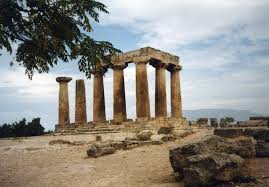 The temple of Apollo, the emblem of ancient Corinth, today, stands on a flat rock, above the ancient agora. It is one of the earliest ancient structures that survived the total destruction of the city by the Roman general Mommios in 146 BC.
The temple of Apollo, the emblem of ancient Corinth, today, stands on a flat rock, above the ancient agora. It is one of the earliest ancient structures that survived the total destruction of the city by the Roman general Mommios in 146 BC.Ancient Corinth was one of the cradles of early Doric temple building from the Geometric till the Archaic era (8th – end of 6th century BC). The first temple of Apollo was built in the 7th century BC, as it is testified by the scattered stone fragments and the monumental tiles found on the hill. It was built of stone, plinths and wooden beams and carried a heavy roof of clay tiles. Most probably, it was a simple structure without exterior columns.
Its successor was built in the 6th century BC (560 BC) with an outer colonnade of 6 x 15 monolithic limestone columns. Its central structure was divided into three parts: a “pronaos” (antechamber) with two columns in antis, a central oblong, rectangular room subdivided into two parts (cella) and an “opisthodomos” (rear chamber) with two columns in antis.
This temple testifies the economic and political status of ancient Corinth during the Archaic era when the city had the leading role in the colonization of west Mediterranean. Additionally, its form with the pediments and the clay sphinxes, at the corners, functioned as a prototype for many contemporary temples. On the temple’s ratios and its form, one can see the power of the Archaic era and the establishment of the “petrified” form of Doric temples.
After the destruction of Corinth and its re-founding, a century later, in the Roman period, the temple of Apollo was renovated in order to house the cult of the Emperor. In the Byzantine era a basilica was built on the NE part of the Temple Hill, whereas in the Ottoman period, the eastern part of the Temple was demolished and the residence of the local Turkish Bey was built on top of its “crepis” (elaborate ground floor). Today, although only seven standing columns of the western “pteron” (surrounding colonnade) and part of the crepis and its foundations are preserved, the monument remains the emblem of the Archaeological Site of Ancient Corinth, and remains one of the few standing Archaic Greek Temples in the world.
 In the peaceful hinterland of Epidauros, with its mild climate and abundant mineral springs, the sanctuary of the god-physician Asklepios, the most famous healing centre of the Greek and Roman world, offers visitors the same serenity as once in its glorious years of prosperity.
In the peaceful hinterland of Epidauros, with its mild climate and abundant mineral springs, the sanctuary of the god-physician Asklepios, the most famous healing centre of the Greek and Roman world, offers visitors the same serenity as once in its glorious years of prosperity.The area was devoted to the cult of healing deities since Prehistory, much before the introduction of the cult of Asklepios. A Mycenaean sanctuary dedicated to a healing goddess stands on the Kynortion hill, NE of the Theatre. It was founded in the 16th century BC over the remains of a settlement of the Early and Middle Bronze Age (2800-1800 BC) and functioned until the 11th century BC. Unlike other sanctuaries of this period, this one is unusually large. This early sanctuary was replaced c. 800 BC by another, dedicated to Apollo, a god with healing abilities, worshipped here as Apollo “Maleatas”. The worship of Asklepios, the sanctuary’s main healing god, traditionally considered as the indigenous son of Apollo and the local, Epidaurian princess Koronis, was established in the 6th century BC. Asklepios, protector of human health and personal happiness, was a very popular deity with an ever-increasing number of worshippers. The sanctuary at Kynortion was quickly overwhelmed by a great number of visitors, so a new sanctuary was founded in the plain, approximately one kilometer NW of Kynortion Hill, on the site where, according to the myth, Asklepios was born. The two sanctuaries, one dedicated to Apollo Maleatas and the other to Asklepios, were subsequently known under the common name of “Sanctuary of Apollo Maleatas and Asklepios”.
The Asklepieion at Epidaurus comprises of two sanctuaries dedicated to two healing gods: the earlier sanctuary of Apollo Maleatas on Mt. Kynortion and the later sanctuary of Asklepios in the plain, where the famous healing rituals took place.
The smaller mountainous sanctuary of Apollo Maleatas was continuously occupied from the Early Helladic period (apsidal building) to Roman times. The three terraces of the Mycenaean temenos with its open-air ash altar and area for ritual feasting are still visible. Parts of the tufa foundations of the temple of Apollo erected in 380 BC over the ninth century BC ash altar and of the small Archaic temple of the seventh century BC are preserved on the lower terrace. A monumental tetrastyle altar was built in the Classical period east of the temenos. In the fourth to third centuries BC, during the sanctuary’s most important construction period, a terrace wall was raised along the sanctuary’s northern limits. This wall was lined by a portico facing south. An extremely rare small open-air sanctuary of the Muses dates to this period. The remaining visible monuments – that is, the propylon (entrance gate), the restored Hellenistic house of the priests, the basin of Antonine, of which a large part of the roof is preserved and a fountain – all date to the second century AD.
 The sanctuary of “Amyklaios” Apollo or of “Hyacinth and Apollo” is located 5 kilometers south of Sparta, on the hill of Ayia Kyriake (where the chapel of Ayia Kyriake is) at Amyklai.
The sanctuary of “Amyklaios” Apollo or of “Hyacinth and Apollo” is located 5 kilometers south of Sparta, on the hill of Ayia Kyriake (where the chapel of Ayia Kyriake is) at Amyklai.Much before the construction of the sanctuary, Amyklai was already one of the oldest cities of ancient Greece. Traces of a Middle Helladic settlement (2000 – 1600 BC) have been revealed during the excavations, together with many finds and lots of pits on the ground which holded house storage jars.
Near the end of the Mycenaean era (12th – 11th century BC), the site is converted into a religious center, thus, a sanctuary starts to operate among and over the ruins of the old houses. Most probably the city had been transferred to another location, between modern Amyklaion and Vapheio villages. The plethora of the Geometric vases, found at the sanctuary, testifies that it prospered in the 10th century BC
The end of the 8th and the 7th century BC are marked by the first monumental phase of the site, with extended interventions on the hill: the ruins of the old city are put aside and are used both for the construction of a new peribolos wall and the filling of the ground. A flat area was created, ready for the new building. Amyklaion sanctuary gradually becomes the major political and religious center of Sparta, symbolizing the political reconciliation of Doric Sparta (god Apollo) with the earlier inhabitants of Amyklai (deified Hyacinthos).
According to the myth, Hyacinthos was the younger son of Amyklas and Diomede, a very handsome young man, favored by Apollo. Apollo killed, accidentally, Hyacinthos at a discus-throwing contest. At the very spot where Hyacinthos’ blood dropped, a beautiful flowers sprout, thus called “hyacinth”. It was believed that the initials “YA” were naturally painted on the flower’s petals. Hyacinthos was buried at Amyklai and, later, the “Throne of Apollo” was built over his altar. The “Throne” was a peculiar structure, comprising of stoas and chambers.
It was in the Geometric era (7th century BC) that the aniconic cult “xoanon” (wooden statue) appeared, which, from an initially a small figurine, had been converted into a colossal wooden trunk. The “xoanon” stood on the “Throne of Apollo” and, below, was an inner space, accessed from all sides, where the rituals in honor of Hyacinthos would take place
The “Throne of Apollo” was enlarged in the 6th century BC and became a colossal kind of seat, in the center of which the column-like statue of the god would stand. Pausanias mentions that the statue was of a colossal size (around 14 meters). The statue was, actually, the old aniconic wooden representation of the deity, which was then plated with a bronze sheet by Bathykles sculptor from Magnesia of Asia Minor. The god was holding a sword and a bow and was wearing a helmet. The throne itself was the work of Bathykles as well: the seat was made of horizontal beams. At the façade, it is supported by 4 female columns. The lower and back parts were decorated by sculptural mythological scenes, i.e. representations of nymphs being kidnapped by gods, Perseus beheading Medusa, goddess Athena leading Herakles on Olympus, scenes from the tasks of Heracles. This structure comprised of stoas and chambers, as well, with an inner peristyle for the attendance of rituals around the tomb-altar of Hyacinthos, being at the same time the pedestal/base of the colossal statue of Apollo. There was a bronze door which gave access to the altar for the sacrifices. Bathykles combined the Doric simplicity with the Ionic elegance and created an excellent work, something obvious on the impressive mixt capitals of the columns. The xoanon-statue of the god projected, like an antenna, on the top of the hill, visible from the lower parts of the valley of Laconia.
The “Hyacinthia” festival took place on the laconic “Ekatomvaea” month (July). It was a major religious festival for the Amyklaians, who would not miss it, no matter how far they were from home. Even during war, they would agree a month’s truce, so as to return home for the festival. The 3-day festival included two days of mourning with light meals and purification rituals and a day’s festivities with feasts, contests, sacrifices and the dedication of a chiton (cover cloth) to Apollo, woven by the Spartan women. The ceremony of the “dedication of the chiton” started with the procession through the “Hyacinthia Odhos” (Hyacinthian Way) which connected Sparta with Amyklai.
Today, one can see traces of a retaining wall, a terrace, precinct walls, some foundations and a circular altar. The architectural fragments of the mixed Doric and Ionic style are displayed in the Archaeological Museum of Sparta.
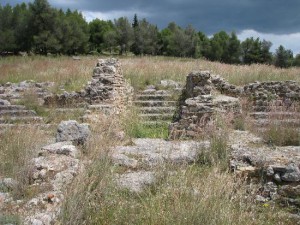 The ancient city of Argos was built on the foot of Larisa acropolis Hill. A second acropolis hill, near Larisa, is the so-called “Aspida” or Prophet Elias (modern name). The ancient city of Argos was built at the foot of Larisa. According to the ancient local tradition, goddess Athena had hidden her shield (“aspida”) on a hill which took the name “Aspida.
The ancient city of Argos was built on the foot of Larisa acropolis Hill. A second acropolis hill, near Larisa, is the so-called “Aspida” or Prophet Elias (modern name). The ancient city of Argos was built at the foot of Larisa. According to the ancient local tradition, goddess Athena had hidden her shield (“aspida”) on a hill which took the name “Aspida.The sanctuary of Apollo “Deiradiotes” or “Pythios” was built in the 6th century BC, on the saddle, between the two acropolises, the so-called “Deiras” (saddle). Pausanias (II 24,1-2) mentions a temple of Apollo, built by the Delphian Pytheas and a bronze statue of the god which stood inside the temple in an upraised position. He mentions the existence of an oracle there, functioning once a month, where the priestess Pythia, before giving the oracular, drinks from the blood of a sacrificed goat.
The surviving parts of the sanctuary are a monumental staircase and an altar. The ruins of a byzantine basilica are visible SE of the altar. Further to the east, on a terrace, there is a rectangular hypostyle structure, perhaps an oracle and, on a third terrace, the foundations of another structure can be seen, housing a cistern, perhaps an Asclepion. On a lower terrace, in the south, the traces of a tholos can be seen, perhaps the sanctuary of goddess Athena.
The cult in the site is testified from the Archaic era (6th century BC) but the surviving traces date from the 4th century BC. The cult continues in the Christian era with the construction of successive basilicas.
Today, the monumental staircase and the open area, in front, are used for cultural performances.
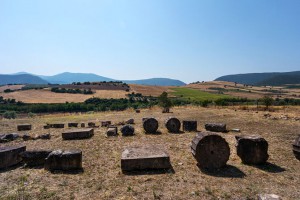 The sanctuary is located 700 meters NE of Kalapodi village, opposite the church of Ayioi Apostoloi, on the National Road Atalante – Delphi. It was traced by the German Archaeological Institute and, according to ancient (Herodotus VIII, 33) is among the most important sanctuaries of the area.
The sanctuary is located 700 meters NE of Kalapodi village, opposite the church of Ayioi Apostoloi, on the National Road Atalante – Delphi. It was traced by the German Archaeological Institute and, according to ancient (Herodotus VIII, 33) is among the most important sanctuaries of the area.The site has been identified with the cult center and oracle of Apollo of Abae, a tribal sanctuary with a great fame. From the early Archaic era (7th century BC) the center of the sanctuary is occupied by two parallel temple structures, known by the excavators as north and south temples. The north temple has been identified by Felsch as the temple of Apollo, while the south temple as the temple of “Elaphebolos” Artemis. Here, we have a continuous religious activity for 1.500 years, starting with Mycenaean traces and ending with a structure from the age of Hadrian (2nd century AD).
The beginning of the cult goes back to the Mycenaean era (15th century BC). Later and over the ruins of the Mycenaean shrine, an important Geometric (9th – 7th century BC) sanctuary was built, comprising of two temples, an altar and an open court, in front, for the rituals. The south temple was actually built over the ruins of the Mycenaean shrine and was dedicated to Artemis, while the north temple, with an “eschara”-altar was built on “new” ground and was dedicated to Apollo. The eschara-altar indicates chthonian (oracular) rituals. According to the excavators, here at this sanctuary, the cult of Apollo is introduced for the first time. These temples were enlarged in the beginning of the 7th century BC and belong to the first “prostyle” temples in Greece. They functioned until they were burnt down by a fire, in the beginning of the Archaic era (6th century BC).
Soon after the fire, the temples were restored, in the same age (Archaic). It was actually after the victory of the Phocaeans (A’ Sacred War, 560 BC) that it was decided to create the center of worship of Phocis here and celebrate the “Elaphebolia” in honor of Artemis. For this reason, they covered the earlier temples with earth and created a flat surface for the new temples: two peripteral temples, parallel to each other. The northern one was dedicated to Apollo (44,50 x 14 meters and 18 x 6 columns). The southern one was smaller (26,28 x 13,62 meters and 11 x 6 columns). Both temples comprised of mixt wooden and stone columns and their walls were made of raw plinths, covered with plaster, while their roofs comprised of a wooden structure covered with thick tiles.
The Archaic sanctuary was burnt down by the Persians, after the Battle of Thermopylae (480 BC). After the end of the Persian Wars, it was decided to build just one classical temple over the ruins of the previous ones, in the southern side: this temple was dedicated to Artemis. Over the ruins of the northern temple, it was just an altar that was placed: it was actually a low mount of clay that was placed with a pillar to serve as a table of offerings. This table carried a temporary bust of Apollo, instead of a cult statue. This classical altar of Apollo is a unique discovery in Greece, since it was found intact, with all the equipment of the last ritual like rings, pins, a big spit, a clay female mask and a unique bronze kouros dated from 500 – 490 BC and created in a local workshop. The classical temple of Artemis was destroyed by the serious earthquake of 426 BC.
The temple was rebuilt according to a new architectural plan, which shows …επιρροές from the Parthenon and the temple of Apollo at Bassae. The temple of Artemis was ready in 400 BC, but the date of its destruction remains unknown. It was a peripteral Doric temple (45,80 x 19,26 meters and 14 x 6 columns) with a pronaos, cella with an Adyton and an opisthodomos, with a total of 520 drums. Its construction started in 426 BC (right after the earthquake) and its plan was based on the principles of the Athenian architecture school –Iktinos could have been its architect.
Pausanias mentions that the temple would open only twice a year, for the “Elaphebolia”, the ancient festival and, probably, for the “Kaisareia”, which, at his time, was a great festival in which Roman emperors participated. At the end of antiquity, the Egyptian gods Isis, Osiris and Anoubis were worshipped, as well, in the sanctuary. These cults have been testified dedicatory inscriptions of the 3rd century AD. The sanctuary was abandoned during the reign of the Byzantine emperor Theodosius A’ (4th century AD). It was looted by fanatic Goths and later during the Christian era.
The excavations have brought to light a plethora of finds. From the layer of the Persian destruction, we have dedications of 8 chariot wheels and a bronze decoration of a scepter in the form of a ram-head. From the earlier buildings of the south Archaic temple, we have fragments of frescoes of the 7th century BC, a total of 13 swords and 5 spear heads of the 8th century BC and a bronze “phiale” (plate-like vessel), from N Syria, among others. A painted Mycenaean crater is of the important finds.
“Elaphebolia” was the ancient Greek festival in honor of Artemis “Elaphebolos” (she who hits the dear). The 9th Attic month “Elaphebolion” (February – March) got its name from this festival. The festival took place on the 6th day of the month, in many regions in Greece. From the little information that we have, we know that during the festival, sacrifices of deer would take place. Most probably, in later years, these sacrifices were replaced by delights, in the form of deer, made of flour, honey and sesame. Plutarch mentions that the Elaphebolia was the greatest festival of the ancient town of Hyambolis in Phocis, which was celebrated in commemoration of a victory in the battle of the inhabitants against the Thessalians. He also mentioned that there was a temple dedicated to Artemis, in the town.
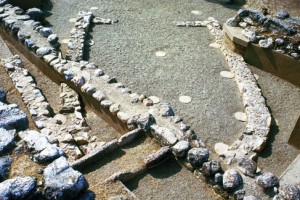 The temple of Apollo Daphnephoros is the most important and widely known monument of Eretria. Together with its enclosure, it constituted the sacred temenos of Apollo, a religious centre and fundamental place of worship, within the core of the ancient city, to the north of its Agora. According to the Homeric hymn to Apollo, when the god was seeking for a location to found his oracle, he arrived at the “Lelantion Pedion” (Lelantine plain).
The temple of Apollo Daphnephoros is the most important and widely known monument of Eretria. Together with its enclosure, it constituted the sacred temenos of Apollo, a religious centre and fundamental place of worship, within the core of the ancient city, to the north of its Agora. According to the Homeric hymn to Apollo, when the god was seeking for a location to found his oracle, he arrived at the “Lelantion Pedion” (Lelantine plain).The first temple is dated from the Geometric period and was situated probably near the harbour, as the sea, at that time, reached the Agora. The “hecatompedon” (100 feet long) apsidal edifice is the earliest in its type among those mentioned by Homer, and slightly posterior to the hecatompedon temple of Hera on the island of Samos. It was flanked to the south by another earlier, apsidal building which also came to light: the so-called “Daphnephorion” (7.5 x 11.5 meters) is the most ancient edifice in Eretria, related to the early cult of Apollo in Delphi. At the centre of this edifice, the clay bases, which supported the laurel trunks, have been preserved. The laurel trunks, on their turn, supported the roof of the Daphnephorion.
In the early 6th century BC, a second hecatompedon temple was erected through earth fills upon its Geometric predecessor, on a solid artificial terrace. This temple comprised of wooden columns (6 x 19) and was subsequently covered with earth in order to build the later and most renowned of all temples in the city. The construction of the renowned temple started in 520 – 490 BC and it was perhaps still unfinished when the Persians razed the city in 490 BC. Poros stones and marble were the materials used for this Doric peristyle (surrounded by colonnades) temple (6 x 14 columns). It had a prodomos (anteroom) and an opisthodomos (back section) arranged with two columns in antis; the cella (in Greek sekos) was divided into three parts by two interior colonnades. After the destruction of the city by the Persians, the temple was repaired and remained in use; yet in 198 BC it was destroyed again, this time by the Romans, a fact which initiated the gradual abandonment and dilapidation of the monument until the first century BC.
The majority of architectural parts from this temple were re-used as construction material; only a few (column) drums together with fragmented capitals and triglyphs remain from the superstructure of the monument. Of the sumptuous sculptural decoration survive only parts of the west pediment featuring in relief the fight of the Amazons (or Amazonomachy, a usual motif for the iconography at the time). The centre was occupied by Athena and is partially preserved, depicting her trunk with the “Gorgoneion” on the thorax; a superb work of art is the complex of Theseus and amazon Antiope marked by sensitivity and softness of the form, internal force and clarity, despite the ornamental tendency obvious in the coiffures and the folds of their clothes.
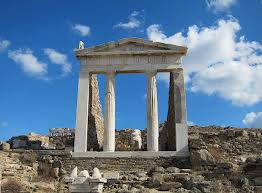 The temples of Apollo on Delos Island were built on a low terrace, next to the water, within the sacred precinct of Apollo. The first temple of Apollo was built in the 6th century BC: a rather small but imposing structure in the simple Doric style with a colonnade, made of local porus stone. A huge cult statue of Apollo, made of a wooden core and sheets of gold and created by the sculptors Tektaios and Agelion, stood inside the temple.
The temples of Apollo on Delos Island were built on a low terrace, next to the water, within the sacred precinct of Apollo. The first temple of Apollo was built in the 6th century BC: a rather small but imposing structure in the simple Doric style with a colonnade, made of local porus stone. A huge cult statue of Apollo, made of a wooden core and sheets of gold and created by the sculptors Tektaios and Agelion, stood inside the temple.The second temple of Apollo, south of the first, was built after 478 BC, when the sanctuary was under the Athenian dominion. It was a Doric peripteral temple with columns in antis, on both sides. This temple remained unfinished: its construction stopped on the level of the entablature, in 454 BC, when the treasury of the allies was transferred from Delos to Athens. The temple was finally concluded after 303 BC. Many traces of shelves were discovered inside the temple, used for the placement of dedications and which made it look like a treasury house.
A third temple dedicated to Apollo was established by the Athenians, in an attempt to propitiate the destroyer and, at the same time, redeemer god. It was the time of the great plague (429 and 427/6 BC). The Athenian temple was raised between the earlier two (the old porus temple and the unfinished one) and was made of Pentelic marble. The whole structure indicates Kallikrates, the architect of Parthenon. The interior was formed in such a way, so as to house a composition of 7 big statues on a semi-circular pedestal (“the house of the seven”). The wooden ceiling panels of the temple were placed at the inclined inner sides of the pitched roof, forming pediments over the inner walls. On top of the temple, the magnificent akroteria: on the western one, goddess Eo raises Kephalus on the air, while on the eastern one, Boreas (northern wind) grabs nymph Oretheia, the daughter of the mythical king of Athens Erechtheus.
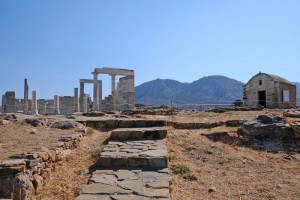 A rural, open-air, cult of earth deities started to be practiced in the 8th century BC, on a mound overlooking a fertile valley. Today, this area is called “Gyroulas”, located south of Sangri village. On the very spot of this open-air cult, a monumental marble temple was erected, later in the late 6th century BC.
A rural, open-air, cult of earth deities started to be practiced in the 8th century BC, on a mound overlooking a fertile valley. Today, this area is called “Gyroulas”, located south of Sangri village. On the very spot of this open-air cult, a monumental marble temple was erected, later in the late 6th century BC.The sanctuary was dedicated to god Apollo, goddess Demeter and Kore and the cult focused on their “chthonian” (earthen) characteristics.
The cult of chthonian deities who are related to fertility and the growth of vegetation can be explained from the creation of such a sanctuary, in the midst of a farming land. The sanctuary became a great center of worship and major factor of social cohesion, in the whole area.
The marble temple represents an important step in the evolution of Greek architecture. During the early Christian era (5th -6th century AD), the temple was converted into a basilica. Until the 8th century AD, when the area was abandoned, various workshops were developed around the basilica, for the production of olive oil, wine and ceramics. Later, the worship was continued in a small one-chamber chapel, dedicated to Saint John the Theologian, erected under the Holy Bema of the ruined basilica. In 1977 and due to the needs of the restoration works, the chapel was relocated, thus brought to its modern position.
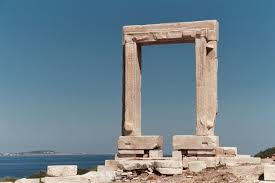 The archaeological site of Portara is located NE of the modern harbor of Naxos town. It presents the most imposing “Porta” (gate) in the Cyclades, called “Portara” by the locals, at an area called Palatia. The Portara (54 x 28 meters) was the gate of the temple dedicated to Apollo, at the islet of Palatia, being connected today with the town by a modern paved walk way. From the mythological background of the islet, we know that this was the spot where Theseus abandoned Ariadne, after the killing of the Minotaur, on his way back to Athens. It was here, where god Dionysos found her and took her with him.
The archaeological site of Portara is located NE of the modern harbor of Naxos town. It presents the most imposing “Porta” (gate) in the Cyclades, called “Portara” by the locals, at an area called Palatia. The Portara (54 x 28 meters) was the gate of the temple dedicated to Apollo, at the islet of Palatia, being connected today with the town by a modern paved walk way. From the mythological background of the islet, we know that this was the spot where Theseus abandoned Ariadne, after the killing of the Minotaur, on his way back to Athens. It was here, where god Dionysos found her and took her with him.Built in the 6th century BC, it comprises of 4 monoliths of Naxian marble, over 6 meters long each and of approximately 20 tons of weigh. The construction of the temple started at around 530 BC, by Lygdamis, the tyrant of Naxos, but was never finished. Lots of stories, created by local imagination, were born out of this fact. The temple was oriented towards the sacred island of Delos.
The temple was converted into a Christian Basilica, during the early Christian years and suffered quarrying many years after, by the Venetians who used it for the construction of the castle.
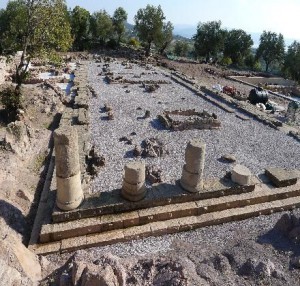 The sanctuary of “Napaeos” Apollo is located at the rural area called “Klopedi”, north of the Gulf of Kalloni and very close to Ayia Paraskevi village, on the island of Lesvos. Here, we have the ruins of two temples of the Archaic era. The temples, known as A and B, were built on a terrace of a low hill and indicate the cult area of which surface ruins are scattered around. This sanctuary is the oldest found on the island of Lesbos and comprises a unique example of the so-called Aeolic style in architecture.
The sanctuary of “Napaeos” Apollo is located at the rural area called “Klopedi”, north of the Gulf of Kalloni and very close to Ayia Paraskevi village, on the island of Lesvos. Here, we have the ruins of two temples of the Archaic era. The temples, known as A and B, were built on a terrace of a low hill and indicate the cult area of which surface ruins are scattered around. This sanctuary is the oldest found on the island of Lesbos and comprises a unique example of the so-called Aeolic style in architecture.The building material comes from the nearby ancient quarry of Petsofas. The traces of the road connecting the sanctuary with the town of Arisbe are still visible.
The earlier of these temples is Temple Α (29,20 x 18,70meters), dated from the Archaic age. The finds indicate a pronaos (antae chamber), main temple and opisthodomos (rear chamber), surrounded by a “pteron” (exterior colonnade).
Temple Β is located a little further to the north, built on the natural flat bedrock. Its stylobate has survived, with the bases of 2 columns on its NW corner. This is an indication of a “pteron” (exterior colonnade) of a total of 46 columns.
The worshipped deity, here, has been identified with the well-known “Napaios” Apollo from the ancient sources. The finds confirm this: a clay slab with the inscription «..ΛΩΝΟΣ» (of Apollo), found in the foundations of Temple A and a part of a bronze kouros figurine, from the cult pedestal of Temple B.
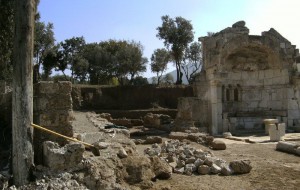 The sanctuary of Delios Apollo which is located between the villages of Chorio and Panormos of the island of Kalymnos had been the political and religious center of the island throughout antiquity. Lots of religious and secular buildings have been found in the surrounding area, like temples dedicated to both Apollo and Asclepius, a theater, a council house, a gymnasium, inscriptions, dedications, statues of gods and mortals, dating from the 4th and 3rd century BC. A plethora of portable finds, like figurines, inscriptions and bases of statues, indicate the continuous use of the site as a sanctuary from the beginning of the 1st millenium BC until the early Christian era.
The sanctuary of Delios Apollo which is located between the villages of Chorio and Panormos of the island of Kalymnos had been the political and religious center of the island throughout antiquity. Lots of religious and secular buildings have been found in the surrounding area, like temples dedicated to both Apollo and Asclepius, a theater, a council house, a gymnasium, inscriptions, dedications, statues of gods and mortals, dating from the 4th and 3rd century BC. A plethora of portable finds, like figurines, inscriptions and bases of statues, indicate the continuous use of the site as a sanctuary from the beginning of the 1st millenium BC until the early Christian era.Today, the dominant features of the site are two early Christian Churches, built in the 5th and 6th century, dedicated to Christ of Jerusalem and Ayia Sophia (Holy Wisdom), accordingly.
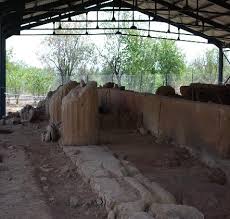 The Archaic temple of Apollo is located at “Lianokokkala”, 12 kilometers W of Karditsa town and 2 kilometers W of Metropolis. Here, on a terrace, S of the course of river Laparda (or Gavria), on the right hand side of the road, leading from Metropoli to Koronas Monastery and lake Plastira, Apollo was worshipped. This location belonged to territory of ancient Metropoli which was an important civil center of Thessaly, during the Hellenistic Age, still buried under the modern village.
The Archaic temple of Apollo is located at “Lianokokkala”, 12 kilometers W of Karditsa town and 2 kilometers W of Metropolis. Here, on a terrace, S of the course of river Laparda (or Gavria), on the right hand side of the road, leading from Metropoli to Koronas Monastery and lake Plastira, Apollo was worshipped. This location belonged to territory of ancient Metropoli which was an important civil center of Thessaly, during the Hellenistic Age, still buried under the modern village.The excavations in the site brought a peripteral, Doric temple to light, with an interior colonnade. Judging from the typology of the capitals of the columns, the roof tiles and the cult statue, the temple has been dated from the middle of the 6th century BC.
A rectangular pedestal, belonging to the cult statue, was found in the middle of the main temple (sekos), in front of the third column of the inner colonnade. The bronzed statue of Apollo, in the form of a “hoplite” and broken in three pieces, was found on the pedestal, on its original position where it stood for ages. Its height is 0,82 meters and dates from the 6th century BC. He is wearing a conical helmet, a breastplate, armbands and greaves. The position of his hands indicates that he was holding a spear with his right hand and perhaps a bow with his left hand. The upper part of the spear has been found as well.
The cult of god Apollo (called “Aploun” in the Thessalian dialect) was very popular in the area of ancient Thessaly. The identification of the bronze statue with god Apollo was confirmed by the discovery of an inscribed dedicatory stele of the 4th century BC, which was found in the temple. The representation of the god as a hoplite is very rare. Furthermore, the coin representations of ancient Metropolis confirm the cult of Apollo in the town.
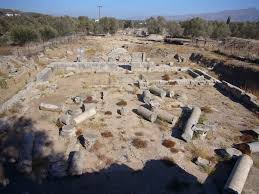 The sanctuary of Apollo which is located in the center of the ancient agora of Gortys was excavated in 1887. This was the most important religious center of the city, before Christianity and the erection of the Basilica of Saint Titus in 500 AD.
The sanctuary of Apollo which is located in the center of the ancient agora of Gortys was excavated in 1887. This was the most important religious center of the city, before Christianity and the erection of the Basilica of Saint Titus in 500 AD.The first structure of the 7th century BC was a 4-sided sekos with four wooden columns in the center, supporting the roof. The exterior walls and the steps of the crepis were all covered with Archaic inscriptions. During the Hellenistic era, a monumental pronaos was added to the temple, together with inscribed stelae, among the columns. Some restorations and additions took place during the Roman times, like the small theater which was built on the western side. At the final phase, during the middle Byzantine years (around the 11th century AD), houses and aqueducts were built over the ancient ruins.
 An important sanctuary, dated from the Archaic to the Hellenistic era, has been excavated on the peninsula of Athos, SW of New Roda. Up to now, two buildings have been brought to light and a third one is being excavated.
An important sanctuary, dated from the Archaic to the Hellenistic era, has been excavated on the peninsula of Athos, SW of New Roda. Up to now, two buildings have been brought to light and a third one is being excavated.The sanctuary was established by the inhabitants of Sane, which was a colony of the island of Andros. A fragment of an inscription, dated from the 5th century BC, indicates the ….όρια of the sanctuary. The prosperity comes in the Hellenistic years when Alexander, Kassander’s brother, builds the city of Ouranoupolis in 315 BC and incorporates the sanctuary into it. He restores the old buildings and builds new ones.
The first building is dated from the Archaic era (6th century BC). It is an “oikos” (sacred house) with a sekos and pronaos in antis, raised on a pedestal (1 meter), decorated with …… κυψελωτό motif on the exterior of its limestone walls. The roof of the oikos is very interesting with its clay, Corinthian tiles and the Nike …acroteria. These Nikes are excellent examples of late Archaic sculpture with few parallels from southern Greece, i.e. Olympia.
The second building is a temple dated from the Hellenistic era. It comprises of a pronaos and a sekos with three entrances, a built bench, a table of offerings and a hearth in the middle. The most interesting finds are two marble heads of god Helios and a woman, found near the eastern entrance of the sekos, a clay altar with painted decoration and a unique clay vase with six sides (hexahedron).
Although the finds from the Archaic building do not give us sufficient information on the worshipped deities, in the sanctuary, those from the Hellenistic building indicate that god Helios or Apollo-Helios was worshipped there, together perhaps with other gods, possibly, Artemis-Selene
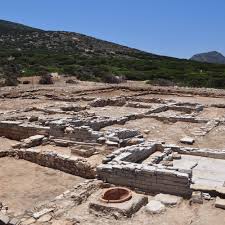 Ambrakia was an ancient city-state of W Greece, built by Arachthos river at the location of contemporary Arta.
Ambrakia was an ancient city-state of W Greece, built by Arachthos river at the location of contemporary Arta.The important temple, dedicated to Apollo “Pythios-Soter” and built in the middle of the ancient city, is located today in the center of Arta, at Kilkis Square. It is dated from in 500 BC, a chronology based on the porus architectural members, found scattered around. There must have been older shrines to Apollo in the same area though. The temple must have functioned as archive since a public record, of the 2nd century BC, has been found, comprising of an inscribed stele with the text of a decree, determining the boundaries between Ambrakia and Charadros after the Roman conquest. This document provides essential information regarding the management of the ancient cities of Epirus.
The magnificent temple was Doric, peripteral with an elongated sekos (44 x 20,75 meters). At the back of the sekos, the foundations of the pedestal of the cult statue of Apollo have been preserved. From the temple itself, the krepis (floor) and foundations have been preserved. The monument served as a quarry in the early Christian era and, a little later, as a cemetery.
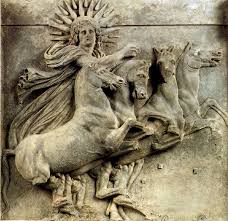 At the SE coast of Thrace, between Ismaros and Evros, in the end of the 7th century BC, Greeks from Samothrace built a chain of fortified cities, called “Samothracian Walls” by Herodotus. These colonies which comprised of the “Peraia” (opposite coast-land) of Samothrace became very important: a land which controlled the passes from east to west gave access to the hinterland and offered urban services and imported goods to the growing elite of the Thracian kingdom of Odryssae. It had been a key choice, which contributed to the Hellenization of the Thracians and brought wealth to the land, as testified by the finds of the excavations at ancient Zone. Ancient sources mention Mesemvria, Dry, Zone, Sale and, later in the Roman era, Tempyra and Charakoma.
At the SE coast of Thrace, between Ismaros and Evros, in the end of the 7th century BC, Greeks from Samothrace built a chain of fortified cities, called “Samothracian Walls” by Herodotus. These colonies which comprised of the “Peraia” (opposite coast-land) of Samothrace became very important: a land which controlled the passes from east to west gave access to the hinterland and offered urban services and imported goods to the growing elite of the Thracian kingdom of Odryssae. It had been a key choice, which contributed to the Hellenization of the Thracians and brought wealth to the land, as testified by the finds of the excavations at ancient Zone. Ancient sources mention Mesemvria, Dry, Zone, Sale and, later in the Roman era, Tempyra and Charakoma.Ancient Zone was the most important and thriving colony of Samothrace. The city had grown on the southern slopes of a low hill, at the foot of Zonaia, reaching the sea and was surrounded by a fortification wall. At the “insulae” (residential quarters), we recognize the characteristics of the typical Greek house of the 5th and 4th century BC. Aphrodite, Dionysos, Demeter and Apollo were worshipped, in the town. Up to now, two sanctuaries have been found: the smaller one, dedicated to Demeter and the other one, dedicated to Apollo.
The temple of Apollo is the most important public building of ancient Zone, within the only Archaic sanctuary identified with Apollo in Thrace. The temple (9 x 15 meters), with an orientation N-S, has survived on the level of the foundations with its 3-stepped “crepis” (floor) in the south. The surviving clay architectural fragments testify its Ionic style dated from the late 6th century BC. It comprises the basic structure of a comparatively large sanctuary (65 x 105 meters) for the size of the city. The foundations of the peribolos wall of the sanctuary are still in situ.
The identification of the temple with Apollo’s cult is based on a plethora of sherds (around 300) bearing the name of the god, found inside and around the temple. These sherds together with 5 stone inscriptions –one of them is bilingual- give us valuable information for the local Thracian dialect. They are inscribed with Greek letters which form a dialect, relative to the Greek language.
 Despotiko, today, is an island, totally separated from nearby Antiparos by a narrow and shallow sea channel. The archaeological site is located opposite Saint George of Antiparos, at a location called “Mandra” which is being systematically excavated by the archaeologist Giannos Kouragios, since 2001. An extensive sanctuary, dedicated to Apollo, has been brought to light. The existence of this sanctuary was unknown due to the lack of inscriptions or ancient sources.
Despotiko, today, is an island, totally separated from nearby Antiparos by a narrow and shallow sea channel. The archaeological site is located opposite Saint George of Antiparos, at a location called “Mandra” which is being systematically excavated by the archaeologist Giannos Kouragios, since 2001. An extensive sanctuary, dedicated to Apollo, has been brought to light. The existence of this sanctuary was unknown due to the lack of inscriptions or ancient sources.Its prosperity is dated from the 6th century BC although the earlier traces of worship go back to the 8th century BC, at least. Up to now, 12 buildings and a dining room have been revealed, together with the Archaic temple.
Artemis and goddess Hestia were worshipped in the sanctuary, together with Apollo. The plethora of finds testify the wealth of the sanctuary and its contacts with the mainland of Greece and the Orient: fragments of at least 60 marble kouros statues, kore statues, elaborate vessels, ivory objects, jewelry, figurines and other.
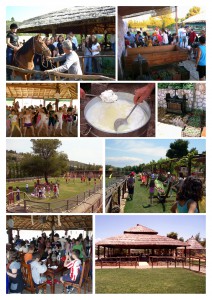 Traditional Park Dimaki is located in the picturesque village of Theologos, only one hour away from the capital city of Athens (120km).
Traditional Park Dimaki is located in the picturesque village of Theologos, only one hour away from the capital city of Athens (120km).
Visitors are able to relax in an environment that revives the old customs of Central Greece.
A guide will show you the old, traditional way of living in the hut, as well as the tools that our ancestors used to make their lives easier.
You will be fascinated by the tranquility of the environment and you can either lay in our hammocks, or ride our horses.
For groups of ten or more people, we can arrange to offer greek delicacies such as cheese pie, spinach pie and more. Price is fixed upon request.
For english speaking people, prior notification to their visit would be appreciated.
Website: www.parkodimaki.gr
Traditional Park Dimaki
- May 30,2016
Traditional Park Dimaki is located in the picturesque village of Theologos, only one hour away from the capital city of Athens (120km). Visitors are able to relax in an environment that revives the old customs of Central Greece. A guide will show you the old, traditional way of living in the hut, as well as the tools that our ancestors used to make their lives easier. You will be fascinated by the tranquility... read more
Ares is the Greek god of war. He’s one of the Twelve Olympians, and the son of Zeus and Hera. In myths, Mars appears bellicose and provocative and represents the impulsive nature of the war.
Thanks to his son Oenomaos from Steropi, Mars became ancestor of renowned people, such as of Atreus, Thyestes, Agamemnon, Menelaus, Aegisthus, Orestes, Electra, Pylades, Pittheus, Theseus, Hippolytus , Iphigenia, Demophon, Akamas, Eurystheus, Amphitryon, Alcmene, Iolaus, Hercules, Admetus, Kopreus, Alkathoos and Ajax of Telamon.
Ares usually appears in battle on foot, breaking the momentum of chariots and demolishing the walls. Other times he is on a chariot with two (Deimos and Phobos), or four magnificent horses (sons of Boreas and Fury) (Phobos, Aithonas, Flogios and Konavos, as Quintus Smyrnaeus calls them).
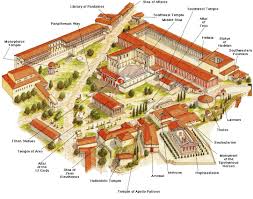 The Temple of Ares, which was excavated in 1937, is one of the four important monuments transferred to the Athenian Agora during the years of Emperor Augustus. It is a typical temple structure of the peak of Athenian 5th century. B.C. architecture. It was moved probably from Mesogeia area, and not from Acharnes, as previously thought. Today it survives in a very poor condition.
The Temple of Ares, which was excavated in 1937, is one of the four important monuments transferred to the Athenian Agora during the years of Emperor Augustus. It is a typical temple structure of the peak of Athenian 5th century. B.C. architecture. It was moved probably from Mesogeia area, and not from Acharnes, as previously thought. Today it survives in a very poor condition.The central triangular space formed between the Middle Stoa, the Panathenaic Way and the road that runs along the east side of the Agora, with buildings dedicated to the worship of the gods and the city administration, acquired new use after the founding of the Roman Agora, during the reign of Augustus. So the space was filled mostly with religious buildings, transferred from other sites (Temple of Ares, Zeus Altar Agoraios, S.E. temple, S.W. temple) and the bulky Odeon of Agrippa.
The Temple of Mars is mentioned by Pausanias (1.8.4), but he did not know that the monument was moved there from elsewhere. This became clear when the site was excavated in 1937. Some architectural fragments, which belonged to the temple, had already been discovered in 1931, when the excavation of the Agora begun.
Only a part of the foundation of the temple survives, at the eastern end of stereobate. It consists of limestone in second use, placed on a layer of crushed stones. The shape of the building, is revealed by the excavation as indicated by the incision made in the rock, during its placement.
The temple was cut to pieces and transported as such in the Agora of Athens during Augustus’ reign. Previously was thought to have been transferred from the town of Acharnes, where sources report an important temple and worship of Mars in general. However, recent research has shown that this is not true. More probable today seems Manolis Korres view, who claims the temple to have been moved there from Mesogeia, namely Pallini (where it was originally dedicated to Athena). Other opinions (that the temple stood somewhere in the asty [city] or even the market) are completely unfounded. Obviously, the transfer of the temple and its dedication on Mars, are associated with the cult of the imperial family: Augustus grandson Gaius, who was extremely popular in the East, was worshiped in Greece by the nickname “New Mars”, as evidenced by inscription 2 AD, possibly associated with the re-dedication of the temple (IG II² 3250). This identification undoubtedly gave impetus to the cult of Mars on the eastern Roman Empire, along with the fact that one of the deities August especially promoted in Rome itself was Mars Ultor.
The view of transfer is based on the fact that in many of the 200 surviving architectural parts of the superstructure (which is recognizable thanks to its characteristic pentelic marble with veins of gray-greenish chlorite) that were found over a wide area in the Agora, engraved tectonic marks have been preserved, that guided the builders of the Roman period for the position they had to be placed during the reassembly of the temple (e.g. AP = left, O = opisthodomos, B = second tier of stereobate, E = efthyntiria etc. .).
Of the four surviving column drums, one was found near the temple, the second at the southwest end of the Agora (now incorporated in the restored northern column of the portico of Hephaestus temple), while two others were later used as millstones. Members from every part of the temple were also found (triglyphs, capitals, architrave, marble tiles, etc.), which clearly show both the layout and the style of the temple.
The drainpipe of Poseidon’s temple in Sounion was found in the same area. It seems that it was moved here in order to be placed in the temple of Mars.
The temple is a typical sample of Athenian architecture, of the third quarter of the 5th century BC. According to Dinsmoor, it is one of the four surviving works of the so called “Architect of the Hephaisteion”, and even the third one chronologically dated in the period from 436 to 432 BC, in the middle of Pericles program. The other three temples are, in order of erection and always according to Dinsmoor, the Hephaisteion (449-444 BC), the temple of Poseidon in Sounion and even later, the temple of Nemesis at Rhamnus (432 BC). As for the design and execution of construction, the temple of Mars is the one closest to the Hephaisteion.
It is a hexastyle Doric temple, double in antis, with narthex, nave and opisthodomos. Its dimensions are: stereobate 17 × 0, 36 m., 15., 88 × 34,71 m. at the stylobate and at the height of the Doric frieze 14,51 × 34,04 m. It had 13 columns on the long side, according to the model of Doric buildings of the era. The height of the columns has been estimated at 6.02 to 6.20 m. The axis space between the columns was defined from 2.68 to 2.69 m., except on the corner, which is estimated at 2.48 to 2.49 m. Although the lower part of the pediments was reinforced in order to place sculptures, there is no indication of sculptural relief decoration on the preserved fragments. A fragmentary marble sculpture, whose parts were discovered during the excavation of the trench for the electric railway in 1891, as well as during excavations in 1951, may have belonged to the temple as a finial. It is a wingless female figure moving towards the viewer.
The Temple of Mars was destroyed in 267 AD during the raid of the Herulians in Athens. Significant parts of the superstructure, out of Pentelic marble, were walled in the roman walls. The destruction was not complete however, as it was partly incorporated into the Late Roman Villa or Gymnasium in the 5th century. A.D.
The foundations of the Altar of Mars, located about 10 m. in front of the facade of the temple, is the only surviving part from the monument. The dimensions of the foundation is 6, 30 × 8, 90 m. It consists of reused limestone. In the eastern part of the foundation stood the altar, while on the west there was a staircase. The architectural parts preserved testify that the altar, which was also moved to its final location at the same time as the temple, dated to the second half of 4th century. B.C.
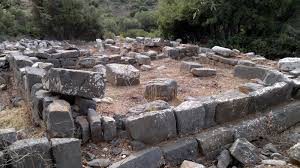 In a flat area near the present village Hellinika, between Agios Nikolaos and Elounda, in the border area of the ancient city-states Lato and Olous, there was a very old sanctuary dedicated to Aphrodite, the “Ancient Aphrodision” as mentioned in inscriptions of the 2nd c. B.C. The place took on new significance when conflicts between the two cities on border disputes escalated and approximately in the position of the dilapidated one-room geometrical temple, in 2nd century. B.C. the temple for two synnaoi deities [worshipped in the same temple], Mars and Venus was erected. The rectangular geometric era temple, measuring 4 x 9 m. was oriented to the west. In front of the facade was the trapezoidal altar, which probably was the center of a vestibule with five columns. According to the excavators the building was not used after the Geometric period and possibly at the end of the 2nd century. B.C. was already in ruins. To the west of the geometric period altar, the newer two-aisled temple was founded by the city of Lato, oriented to the east, with common nave for the two aisles, which was built later on top of the geometric period altar. For each of the houses there was separate entrance door from the common vestibule. The stone lintel of the eastern door of the south aisle, dedicated to Mars, is preserved, as seen from a discovered inscription that refers to construction work in the temple of Mars, and there was another access to it from the south wall of the building. From the inscriptions, the progress of construction projects and subsequent additions and repairs of the later temple are made obvious as well as the development of border disputes which were resolved, since assistance was required through arbitrations and setting of borderlines, by the Knossians, Romans and Miletians. The arbitrations and related conditions should also be placed in the “Dera sanctuary” or the temple of Mars in Dera area -and indeed many of them were found in the sanctuary of Lenika. Eventually the sanctuary and the region were attributed to Lato.
In a flat area near the present village Hellinika, between Agios Nikolaos and Elounda, in the border area of the ancient city-states Lato and Olous, there was a very old sanctuary dedicated to Aphrodite, the “Ancient Aphrodision” as mentioned in inscriptions of the 2nd c. B.C. The place took on new significance when conflicts between the two cities on border disputes escalated and approximately in the position of the dilapidated one-room geometrical temple, in 2nd century. B.C. the temple for two synnaoi deities [worshipped in the same temple], Mars and Venus was erected. The rectangular geometric era temple, measuring 4 x 9 m. was oriented to the west. In front of the facade was the trapezoidal altar, which probably was the center of a vestibule with five columns. According to the excavators the building was not used after the Geometric period and possibly at the end of the 2nd century. B.C. was already in ruins. To the west of the geometric period altar, the newer two-aisled temple was founded by the city of Lato, oriented to the east, with common nave for the two aisles, which was built later on top of the geometric period altar. For each of the houses there was separate entrance door from the common vestibule. The stone lintel of the eastern door of the south aisle, dedicated to Mars, is preserved, as seen from a discovered inscription that refers to construction work in the temple of Mars, and there was another access to it from the south wall of the building. From the inscriptions, the progress of construction projects and subsequent additions and repairs of the later temple are made obvious as well as the development of border disputes which were resolved, since assistance was required through arbitrations and setting of borderlines, by the Knossians, Romans and Miletians. The arbitrations and related conditions should also be placed in the “Dera sanctuary” or the temple of Mars in Dera area -and indeed many of them were found in the sanctuary of Lenika. Eventually the sanctuary and the region were attributed to Lato.Artemis was Leto’s maidenly and wild daughter, Zeus’ untamed offspring and Apollo’s twin sister. She was the queen of mountains and woods, goddess of hunting, protectress of birth and mistress of the beasts. As a “Nykterophoitos” (wanderer of the night) and torch-bearer goddess, she would rush, in the night, onto the highest unbeaten mountain peaks along with the wind.
Her and her brother’s birth was the cause of the appearance of Delos Island in the Aegean. A sacred land, with a predetermined position in the Greek Mythology, where the two deities of Light were born: Apollo, god of the day-light and Artemis, goddess of the night-light. Their birth land, before becoming “Delos” (visible), was a floating, wandering rock, called “Ortygia” or “Adelos” (invisible). When pregnant Leto was in search of a land in order to give birth, away from Hera’s wrath, Zeus asked his brother Poseidon to help in finding a place somewhere in the sea. Poseidon then, took the invisible, floating rock “Adelos”, anchored it with four huge diamond chains and named it “Delos”. Leto, after promising Delos eternal light and prosperity, comes to the sacred lake, not far from the foot of Kythnos Mountain. She gives birth to Artemis first, all alone, since Hera had forbidden midwife-goddess Eileithyia to be present. Nine days later, with the help of the divine new-born Artemis, she gave birth to Apollo. Leto kept her promise: since that moment, Delos has been a sacred island, bathed by Apollo’s Light.
Artemis was a very sui generis goddess. From birth, she acts like midwife, becoming this way, the protectress of birth. From childhood, being always aware of her desires, she takes firm and rigid decisions. Zeus admired her persistence and her ingenuity and did all her favors. The first favor Artemis asked, as a gift, was eternal purity and virginity. She was active, tough and restless, conscious, mature and determined and she could become ruthless, without forgiveness, against the violator of her severe rules. She was the “Potnia Theron” (mistress of the beasts) and the “Agrotera” (huntress) of Homer, with a universal sovereignty on nature: tamed and wild animals, fish and birds, were all under her protection. Being the “Goddess of the Selene” (moon), according to the Orphic hymn, she was associated with the Moon and Hekate, as well. Hekate, the “Trimorphic” great goddess, is present in all three worlds (universal). But when she acquires a specific form, then the professed part of hers becomes Artemis. On the other hand, Selene (Moon) expresses the condensed ideas of the goddess, like the Sun does of Apollo. “Selene” derives from “selas”, the light which accompanies the Night and Artemis was “nykterophoitos”-night wanderer. The two goddesses are connected with a deep relation, being though different from each other. They both appear in representations, holding lit torches. Artemis incorporated many old prehistoric deities, like Vritomartys, Diktynna, Kallisto and Laphria.
Her various and diverse symbols were animals, plants and weapons. The basic ones were the arrow, the crescent and the deer.
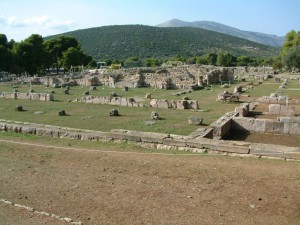 The Epidaurian sanctuary occupies a valley at the foot of Kynortion Mountain, where lots of water flows from the high springs. Here, among the sacred buildings, in the central part of the sanctuary and SA of the temple of Asclepius, is a small temple dedicated to Artemis. It was built in the end of the 4th century BC, together with the rest of the monuments of the sanctuary, which was then restored, in order to become a brilliant Art-Therapy center.
The Epidaurian sanctuary occupies a valley at the foot of Kynortion Mountain, where lots of water flows from the high springs. Here, among the sacred buildings, in the central part of the sanctuary and SA of the temple of Asclepius, is a small temple dedicated to Artemis. It was built in the end of the 4th century BC, together with the rest of the monuments of the sanctuary, which was then restored, in order to become a brilliant Art-Therapy center.The temple of Artemis was a “prostyle” structure, with 6 Doric columns at the façade and an inner Corinthian colonnade in the “Greek p” form. The temple had a Doric entablature with decorative acanthuses on the sime and water spouts in the form of boars’ and dogs’ heads instead of the ordinary lions’ heads. One can see the hunting aspect of the goddess here. According to an inscription, the Epidaurian cult of the goddess is dated from the classical era (5th century BC) and focuses on the chthonian character of the goddess, worshipped as Artemis-Hekate. This aspect of the goddess was highly connected with the chthonian Asclepius, her nephew, being the son of Apollo. Her cult statue was standing in the cella. The altar, in front of the eastern side of the temple and its façade, would offer access to the entrance of the temple, via a paved corridor.
The temple is mentioned by Pausanias and its position was testified after the discovery of an inscribed statue-base, bearing the name of the goddess, on the eastern side of the temple.
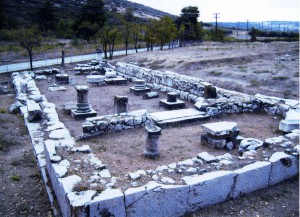 Aulis was an ancient religious center which belonged to the city of Tanagra, from the 4th century BC onwards. The sanctuary of Aulis is testified by Homer (Iliad), Strabo (9.2.8) and Pausanias (9.19.6). It is located on an outcrop of NE Boeotia, at a bay, called “Mikro Vathy”, in the southern coast of the Euboean Gulf. The site is reached via the road from Athens to Chalkis. The sanctuary, within an industrial area, today, was discovered in 1941. It was excavated by Ioannis Threpsiades in 1956. The road that crosses the archaeological site has been called I. Threpsiades Street in his honor. Aulis is known from the Trojan War and the sacrifice of Iphigenia. Agamemnon was forced to sacrifice his daughter, Iphigenia, to infuriated Artemis, in order to let the fair wind free, permitting this way, safe sailing towards Troy. The 1.000 ships of the Greek fleet were, most probably, anchored at the more suitable bay of Glyfa, near Chalkis, some distance away from the small bay of Aulis.
Aulis was an ancient religious center which belonged to the city of Tanagra, from the 4th century BC onwards. The sanctuary of Aulis is testified by Homer (Iliad), Strabo (9.2.8) and Pausanias (9.19.6). It is located on an outcrop of NE Boeotia, at a bay, called “Mikro Vathy”, in the southern coast of the Euboean Gulf. The site is reached via the road from Athens to Chalkis. The sanctuary, within an industrial area, today, was discovered in 1941. It was excavated by Ioannis Threpsiades in 1956. The road that crosses the archaeological site has been called I. Threpsiades Street in his honor. Aulis is known from the Trojan War and the sacrifice of Iphigenia. Agamemnon was forced to sacrifice his daughter, Iphigenia, to infuriated Artemis, in order to let the fair wind free, permitting this way, safe sailing towards Troy. The 1.000 ships of the Greek fleet were, most probably, anchored at the more suitable bay of Glyfa, near Chalkis, some distance away from the small bay of Aulis.The greater area of Aulis was inhabited in the Mycenaean era (16th – 12th century BC). An apsidal structure of the Geometric years (10th – 8th century BC) has been found under the ruins of the classical temple of Artemis. Her sanctuary includes the temple, the sacred fountain and other buildings of the Hellenistic Age (3rd – 2nd century BC), together with the “thermes” (baths) of the late Roman years.
The classical temple of Artemis was built in the 5th century BC, probably over the ruins of an older one. It is a temple of 9,40 x 31 meters, with a “pronaos” at the façade and a cella divided in three aisles with two rows of Ionic columns and a marble door leading to an Adyton. The statues of Artemis and Apollo would stand at the entrance of the Adyton. Statues, dedication bases, small “thesauruses” and tables of offerings were found inside the temple.
The sacred fountain, with the “aglaon hydor” (bright clean water) of Homer, is located east of the temple, surrounded by a wall. The water was pumped from a nearby square cistern, accessible by a staircase. It is possible that the cult of Artemis, initially, started from that spring and the outdoor altars, around it (Iliad Β, 303-307). In the Hellenistic period, a group of buildings was built around the central square, dated from the 3rd and 2nd century BC, south of the temple. Some of the buildings functioned as potters’ workshops, while one of them functioned as “xenon” (hostel) for the visitors. Later, after the destruction of the temple in 396 AD, “thermes” (baths) would cover its ruins which were used as constructive material.
Aulis became the scene of an event, described by Homer in his Iliad: a huge, three-headed monster with a crimson back, which appeared at Aulis the moment of a sacrifice, under the plane tree of the sacred spring, swallowed 8 small sparrows and their mother. The monster disappeared immediately after the event. This was the unmistakable sign, interpreted by the unsighted seer Kalchas: the Greeks would besiege Troy, for 9 years, before they conquer the city on the 10th year. Homer mentions that a piece of this huge plane tree had survived, in his years and Pausanias, about 1000 later from Homer, informs us that the sacred piece was kept in the temple: we may presume that the stone base, next to the 2nd column, from the entrance, may have been the spot where that piece was supported.
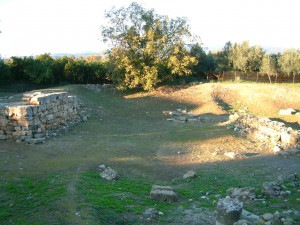 The major Spartan sanctuary of Artemis “Orthia” was built near the west banks of Eurotas River, at the ancient municipality of Limnes, very close to the gate of the ancient city. Today, the visitor of the sanctuary site can see the crepis of the temple, the traces of the altar and parts of the foundations of the theater.
The major Spartan sanctuary of Artemis “Orthia” was built near the west banks of Eurotas River, at the ancient municipality of Limnes, very close to the gate of the ancient city. Today, the visitor of the sanctuary site can see the crepis of the temple, the traces of the altar and parts of the foundations of the theater.The sanctuary of Artemis Orthia was the religious center of the young Spartan “agoge” (education), a very important issue for the Spartan state, where discipline, in certain rules, was a matter of survival.
According to the excavators, the cult of Artemis started, in Sparta, in the 9th century BC. Initially, the sanctuary comprised of an outdoor temenos and an altar. The first temple was built in the 8th or 7th century BC and was destroyed in the 6th century BC from a flood of the river. A new temple was built over the ruins, which is visible nowadays. A rectangular altar survives, in front of it, built of large stone slabs.
This second temple went through some restoration phases in the end of antiquity. A big change in the site happened in the 3rd century AD, when a theater was built, east of the temple and a new, larger altar, was built closer to the temple. The pilgrims and the spectators would attend the ritual contests of young Spartans in the theater. Clay masks have been found inside the theater, probably used in orgiastic rites that took place in the sanctuary. The marble stelae with the sickles and the inscribed altars were dedications of the young Spartans who had passed the “test”, called “Diamastigosis” (striping) and had managed to be classified as “epheboi”.
According to Pindar, the ancients believed that “Orthia” or “Orthasia” Artemis supported the raising of the children or upraised those who had fallen. Pausanias (Laconika 16, 7) says that the “xoanon” (wooden cult statue) of the goddess, had been stolen from Taurike, by Orestes and Iphigenia and was brought to Sparta by them. This xoanon was called “Orthia” and “Lygodesma” as well, meaning “tied up by wicker branches”. Having found it, tied up with the branches of a wicker tree, Orestes and Iphigenia had to carry it in an upraised position (“Orthia”). The epithet “Orthia” most probably, belonged to a Mycenaean goddess of fertility with whom Artemis was identified later in the historic years. We know, from Pausanias, that when the Spartans found the “xoanon” of the goddess, they turned insane and, during the sacrifice in honor of the goddess, they started fighting against each other and many were killed on the altar. The oracle of Delphi advised them to sprinkle the altar with human blood, as atonement, for the sacrilege of accepting the stolen “xoanon”. Lykourgos, the wise Spartan law-giver then, established a religious festival including the striping of the young Spartans on the altar, instead of the human sacrifice. This was the ritual of endurance, called “Diamastigosis”. During the festival, crowds of people watched the rituals, the sacred dances and the races.
The Spartan children (age between 7-13 years) participated in the contests, divided in three age groups. The prize was always an iron sickle. The contests included a kind of chase, called “katheratorion”, a singing performance, called “moa” (muse) and recitation, called “kelea”. The older children participated in the “Diamastigosis” which took place at the altar. The winners were called “vomonikes” (altar-winners). Juicy pliable rods were used for the striping: they believed that the miraculous herbal power, which makes the trees grow, was transferred to the striped body thus making it stronger.
The excavations have testified that ritual dances, in honor of the goddess, would take place around the altar of the goddess, by disguised citizens wearing masks, just like in the theaters.
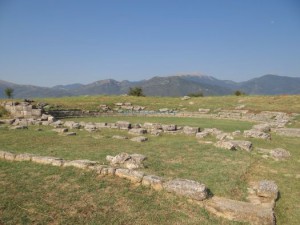 On the western slope of Gortsouli hill, at the area of ancient Mantineia, the ruins of an archaic temple enlighten our knowledge regarding the history of the pre-classical city of Mantineia. Gortsouli is identified with “Ptolis”, mentioned by Pausanias (8.8.4) as the prehistoric acropolis of the ancient city of Mantineia. During the Archaic Age (7th – 6th century BC), Ptolis became the central sanctuary of the Mantineians who still lived in villages (“komae”), in the plain at the foot of the hill. The excavations have testified that an outdoor cult was being practiced in the site, with no interruption from the end of the 8th till the 6th century BC. After an unsuccessful attempt to build a temple in the 7th century BC, due to the collapse of the newly built foundations down the hill, the temple was, finally built a century later. The same blocks of stone were reused for the new temple which was built on the pre-existing foundations and functioned till the 3rd century BC.
On the western slope of Gortsouli hill, at the area of ancient Mantineia, the ruins of an archaic temple enlighten our knowledge regarding the history of the pre-classical city of Mantineia. Gortsouli is identified with “Ptolis”, mentioned by Pausanias (8.8.4) as the prehistoric acropolis of the ancient city of Mantineia. During the Archaic Age (7th – 6th century BC), Ptolis became the central sanctuary of the Mantineians who still lived in villages (“komae”), in the plain at the foot of the hill. The excavations have testified that an outdoor cult was being practiced in the site, with no interruption from the end of the 8th till the 6th century BC. After an unsuccessful attempt to build a temple in the 7th century BC, due to the collapse of the newly built foundations down the hill, the temple was, finally built a century later. The same blocks of stone were reused for the new temple which was built on the pre-existing foundations and functioned till the 3rd century BC.In general, the 6th century-building presents many similarities with its unlucky predecessor: a significant prolongation of the axis oriented from north to south, with the narrow entrance in the southern side. It comprises of a “prodomos” (anteroom), a “sekos” (cella) and an Adyton (enclosed sanctuary, not accessible to all), with internal dimensions of 14.60 x 4.65 meters.
Votive offerings of significance were discovered in the interior of the temple. The most precious group of offerings includes clay figurines representing exclusively feminine figures, in an impressive variety of types. These votive offerings are dated between the 7th and the early 5th century BC and testify the cult of goddess Artemis, as protectress of vegetation and as “kourotrophos” (breeder of babies). Among the types of figurines, one distinguishes for its imposing veil-bearers of significant height; it is the first time that such a type of figurines occurs. Also noteworthy, among the excavation finds, is an ensemble of iron pins, unparalleled in volume and state of preservation, recalling as to the typology the bronze pins that were also found in abundance within the temple. Many of the finds are displayed in the Archaeological Museum of Tripolis.
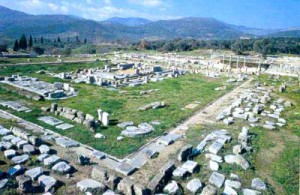 The studies in the area start in 1843, when Ph. Le Bas studied the foundations of an Ionic small temple, an altar and a peribolos wall. The ruins were located at the site of “Spelouza”, on a terrace of Ithome Hill, NE of Mavrommati village. The inscriptions that were found, during the excavations, have identified the ruins with the sanctuary of Artemis. For many years, the site was hidden in the dense vegetation and, only after the recent work of P. Themelis in the greater site of ancient Messene, it was brought to light.
The studies in the area start in 1843, when Ph. Le Bas studied the foundations of an Ionic small temple, an altar and a peribolos wall. The ruins were located at the site of “Spelouza”, on a terrace of Ithome Hill, NE of Mavrommati village. The inscriptions that were found, during the excavations, have identified the ruins with the sanctuary of Artemis. For many years, the site was hidden in the dense vegetation and, only after the recent work of P. Themelis in the greater site of ancient Messene, it was brought to light.In the middle of the Ionic temple, the limestone pedestal of the cult statue is still in situ. Additionally, the altar and a part of the peribolos wall, together with auxiliary buildings have been revealed. Le Bas proposes that this Artemis “Limnatis”, of the inscriptions, should be identified with “Laphria”, a prehellenic deity of nature, life and death. This argument is also testified by Pausanias who mentions only Laphria in the sanctuary and not Limnatis. Moreover, he mentions her cult statue, as the work of the Messenian sculptor Damophon and rituals that took place in honor of Artemis Laphria. The cult of Laphria was introduced to the sanctuary on Ithome by the Kalydonians.
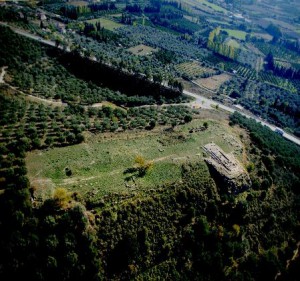 The “petroessa” (rocky) Kalydona of Homer, built on a rocky slope by Evenos River, was a major city in ancient Aetolia. Today, the ruins of the city are observed north of the village Evenochori by the National Road.
The “petroessa” (rocky) Kalydona of Homer, built on a rocky slope by Evenos River, was a major city in ancient Aetolia. Today, the ruins of the city are observed north of the village Evenochori by the National Road.Access to the sanctuary of Artemis “Laphria” starts with the Sacred Way, from the SW gate of the fortification wall of the city and continues, out of the walls. The Sacred Way ends at the sanctuary, which is located west of the city, on a separate hill. This sanctuary was the second Aetolian sanctuary in importance, after the one of ancient Thermos, above Lake Trichonis. Here, together with Artemis Laphria, Apollo Laphrios is worshipped. There are two interpretations regarding the epithet “Laphria”: either Laphria derives from Laphrios, the name of the donor of the cult statue of the goddess or “Laphria” means “lightweight”, since the wrath of the goddess against king Oineas became lighter with the years. Oineas, the famous king of Kalydona and father of Meleagrus, when sacrificing to the gods, had forgotten Artemis who was infuriated and sent the “kalydonian” boar against the Aetolians.
The most ancient signs of the cult of Artemis Laphria are dated from the Geometric era (8th – 7th century BC), as it has been testified by the discovery of an apsidal structure. The peak of the prosperity of the sanctuary is placed in the Archaic era (6th century BC). The prominent location of the sanctuary offers beautiful views towards the river delta of Evenos.
The sanctuary was brought to light in the beginning of the 20th century and all the information of the excavations has been published in the book «Das Laphrion», in 1948, in Copenhagen by Dyggve and Poulsen, who dedicated it to the “Heroic Town of Mesolongi”.
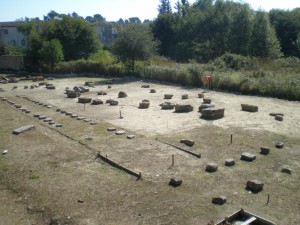 The temple is located at Ayioi Theodoroi. It was recovered incidentally, when fragments of its giant pediment were discovered in the area. Today, these fragments are displayed in the Archaeological Museum of Corfu, being the oldest of the monumental stone pediments of ancient Greek art. The temple is Doric, built in 590-580 BC, with a three-aisled cella, a “pronaos” (ante cella) and an “opisthodomos” (rear chamber).
The temple is located at Ayioi Theodoroi. It was recovered incidentally, when fragments of its giant pediment were discovered in the area. Today, these fragments are displayed in the Archaeological Museum of Corfu, being the oldest of the monumental stone pediments of ancient Greek art. The temple is Doric, built in 590-580 BC, with a three-aisled cella, a “pronaos” (ante cella) and an “opisthodomos” (rear chamber).The big stone pediment which decorated the western side of the temple comprises of a central scene with the Gorgo (Medusa) and the lion-panthers on either side of it and an angular decoration with scenes of the Titanomachy.
A paved road, 3 meters wide, connects the temple with an altar whose southern side is now under the church of Ayioi Theodoroi. The altar comprises of the foundations and a Doric pedestal with triglyphs and metopes. A part of a big retaining wall runs along the northern side of the temple, with the “krepidoma” (floor) of a stoa, in front of it.
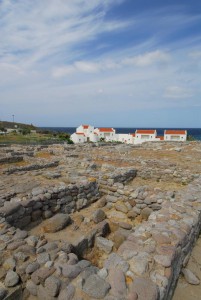 Artemis was the protectress of the ancient city of Myrina. Inscriptions have testified the ruins, found in the land plot of “Porto Myrina” Hotel, as part of the great sanctuary of Artemis. According to the inscriptions, there existed two sanctuaries: a small one within the ancient city walls and a bigger one outside the walls, as per the local custom.
Artemis was the protectress of the ancient city of Myrina. Inscriptions have testified the ruins, found in the land plot of “Porto Myrina” Hotel, as part of the great sanctuary of Artemis. According to the inscriptions, there existed two sanctuaries: a small one within the ancient city walls and a bigger one outside the walls, as per the local custom.The location of the particular sanctuary was indicated by a gigantic goat which would appear in front of travellers during the night.
The sanctuary comprised of a central, open-air, paved court, surrounded by various auxiliary buildings, used by the priests either for the storage of supplies or for the daily cult services. It was enclosed by a double wall with two entrances: one towards the city and the other towards the water, an indication of the existence of a harbor. Among the ruins, three wells and a chamber with inner benches, NW of the sanctuary, testify mystic initiation rituals where ritual water was an important component and initiation gatherings took place. The sanctuary had a long life more than 8 centuries, starting from the early Archaic era (7th century BC) and reaching the end of Antiquity.
The excavation brought to light a plethora of artifacts, including a wealth of ceramics, figurines, perfume vessels, loom weighs and jewelry, exhibited in the Archaeological Museum of Myrina. The bull figurines found within the traces of a sacrificed bull, indicate a connection between Artemis of Lemnos with the Brauroneian Artemis, which can be explained by the fact that Lemnos was at a crossroads of civilizations’ interactions through trade.
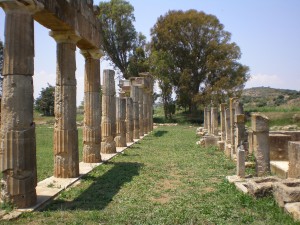 The Doric temple of Artemis which is located on the NW outcrop of the rock of the acropolis, on a stepped terrace, stood out, above all the rest of the sacred buildings. It was built of local porus stone, in the end of the 5th century BC, replacing an older archaic temple. The chapel of Saint George is actually standing over the ruins of that archaic temple.
The Doric temple of Artemis which is located on the NW outcrop of the rock of the acropolis, on a stepped terrace, stood out, above all the rest of the sacred buildings. It was built of local porus stone, in the end of the 5th century BC, replacing an older archaic temple. The chapel of Saint George is actually standing over the ruins of that archaic temple.The cult statue of Artemis has not survived. We know, though, that it was called “agalma orthon” (upraised statue), as it is mentioned on inscriptions found on the Acropolis of Athens. It was attributed to Praxiteles by Euripides, Pausanias and Plutarch.
Here, at the sanctuary, Artemis was co-worshipped with her mother Leto, her brother Apollo, god Dionysos and, primarily, with Iphigenia. The rich dedications that were found, during the excavations, testify the worship of Artemis as the goddess of nature, kourotrophos, protectress of children and little animals. A stately procession (“theoria”) started, every 5th year, from the Acropolis of Athens, in order to reach Brauron, for the celebration of the “Brauronia” festival. Sacrifices, rituals, athletic and music contests and chariot races were held in honor of the goddess, while the important feature of the festival was the ritual of “Arkteia”: an initiation ritual of the young girls, called “arktoi”, before the age of puberty.
The sanctuary of Brauroneia Artemis was located north of the sanctuary of Tauropolos Artemis, at modern Loutsa, in the ancient demos of Araphenides Ales. It was connected with Iphigenia who was the high priest of Artemis and was worshipped in Brauron as a chthonian heroine. Her cult center was a cave which housed her tomb.
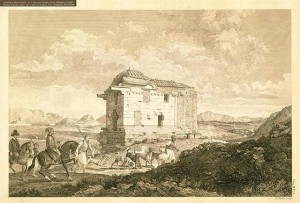 The temple’s ruins are located at the cross-section of Ardettos and Koutoula Streets, close to the site of the Olympieion and beyond the Swimming Center. None of the surviving architectural finds can give us an idea of the complete form of the temple, since only fragments of the foundations are in situ. A testimony of the monument as it stood in 1753, is given by the detailed drawings of elevations, ground plans, members of the temple and its pediment (now in the Museum of Berlin and Venice) executed by architects J. Stewart & N. Revett on their visit to Athens.
The temple’s ruins are located at the cross-section of Ardettos and Koutoula Streets, close to the site of the Olympieion and beyond the Swimming Center. None of the surviving architectural finds can give us an idea of the complete form of the temple, since only fragments of the foundations are in situ. A testimony of the monument as it stood in 1753, is given by the detailed drawings of elevations, ground plans, members of the temple and its pediment (now in the Museum of Berlin and Venice) executed by architects J. Stewart & N. Revett on their visit to Athens.Artemis Agrotera (huntress), among other deities, was connected with the victory of the Athenians against the Persians, in the Battle of Marathon (490 BC) and her cult was introduced to the city of Athens with great enthusiasm. Ancient sources (Aristophanes, Plutarch, Xenophon, and Ailianus) describe annual sacrifices in honor of the goddess, commemorating the great victory, at her sanctuary, located on the southern banks of Ilissos River. Pausanias calls this location “Agrae”.
The temple was converted into a Christian basilica in the 5th century and much later in the 17th century, with the addition of a dome, into the church, dedicated to Virgin Mary known as “Panagia stin Petra”. It was thoroughly destroyed in 1778 by the Ottoman Turks who used it as a quarry for the city’s fortifications.
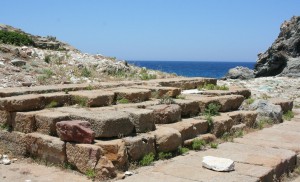 The foundations of the temple of Artemis Tauropolos which were recovered, in 1925, at the coast of Loutsa, were thoroughly studied (1956-57) by the Archaeological Society. They belong to a Doric, peripteral temple, with a cella, comprising of two sections: a spacious eastern, main chamber and an Adyton, behind it. It was built in the end of the 5th century BC.
The foundations of the temple of Artemis Tauropolos which were recovered, in 1925, at the coast of Loutsa, were thoroughly studied (1956-57) by the Archaeological Society. They belong to a Doric, peripteral temple, with a cella, comprising of two sections: a spacious eastern, main chamber and an Adyton, behind it. It was built in the end of the 5th century BC.Euripides and, later, Menander in his comedy “Epitrepontes”, present information about the “Tauropolia”, the religious festival, in honor of the goddess: night parades, Dionysian rituals and mimics of human sacrifices. The sanctuary of Tauropolos was the religious center of the ancient demos “Alos Araphenidon” which belonged to the city-state of Athens. It functioned from the 7th till the 1st century BC, as it is testified by the votive offerings.
Apart from the temple, two “propyla” (elaborate entrances), a cobbled path and some pedestals were revealed, during the excavations. A small temple with an “apothetes” (sacred dumping place) has been discovered, 200 meters south of the temple, containing a plethora of dedications dated from the Geometric and the Classical era. All the finds are displayed in the Archaeological Museum of Brauron.
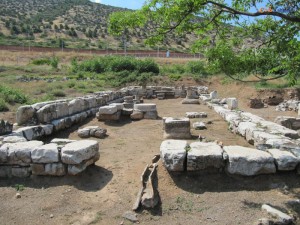 The promontory of Artemision took its name from Artemis “Proseoa” who was worshipped in the region. The epithet “Proseoa” derives from the word “eos” (aurora), meaning she who looks towards dawn. Artemision which is located on the north tip of Euboea Island, opposite Pelion Mountain, has become known from the Sea Battle (of Artemision) between the Greeks and the Persians in August, 480 BC. The sanctuary of Artemis was right at the coast, where the Greek fleet was docked (Herodotus, Historiae Ζ΄ 176 / Plutarch). The strategic position of the region, controlling the narrow pass between the Aegean Sea and the Gulfs of Maliakos, Pagasetic and Euboean, brought a great prosperity to the region during the ancient times. Up to now, there has not been any essential research in the area or excavations and the information we get, derives from the surface ruins and the few written sources.
The promontory of Artemision took its name from Artemis “Proseoa” who was worshipped in the region. The epithet “Proseoa” derives from the word “eos” (aurora), meaning she who looks towards dawn. Artemision which is located on the north tip of Euboea Island, opposite Pelion Mountain, has become known from the Sea Battle (of Artemision) between the Greeks and the Persians in August, 480 BC. The sanctuary of Artemis was right at the coast, where the Greek fleet was docked (Herodotus, Historiae Ζ΄ 176 / Plutarch). The strategic position of the region, controlling the narrow pass between the Aegean Sea and the Gulfs of Maliakos, Pagasetic and Euboean, brought a great prosperity to the region during the ancient times. Up to now, there has not been any essential research in the area or excavations and the information we get, derives from the surface ruins and the few written sources.The sanctuary of “Proseoa” Artemis is located on the low hill called Ayios Georgios, at Pefki, south of the road that leads from Histiaia to Artemision and Chalkis. Plutarch has given a description of it, mentioning a small temple, in a grove, surrounded by lots of dedicatory stelae. One of them belonged to the trophy, dedicated by the Athenians, after the war.
We do not know when the sanctuary was established or its course through history. We deduct some information from two inscriptions about its history and the cult of Artemis. The first one which is kept in the Epigraphic Museum is dated from the 2nd century BC and mentions names of people who participated in a restoration of the sanctuary and the dedication of a cult statue. A big amount of money -8.125 drachmas- was collected for this purpose. The second inscription is dated from the 4th or the 5th century BC and refers to the “pyrrichios” dance which was danced in honor of goddess Artemis. Most probably, the dance was danced by the young people, in commemoration of the Sea Battle of Artemision. There is also a hermaic “stele” (shaft), which is now displayed in the Archaeological Museum of Oreoi and is dated from the 5th century BC. This stele was dedicated to the sanctuary of the goddess by Kephalus, the son of Hegemon and was placed at the entrance of the temple. The German archaeologist G. Lolling excavated the site, just for 7 days, in 1883. This short, but important excavation brought the sanctuary to light, for a while. Very soon, the ruins returned to their darkness, after the construction of the church of Saint George, followed by the establishment of a cemetery, on the same spot. Lolling’s excavation seems to have been forgotten, but, at least, the cemetery has been relocated, leaving the site free for further investigation
Although all the finds of Lolling’s excavation are gone, we know that he had found a few traces from the temple, fragments from the walls and entablature, a part of a clay sime and some “akrokerama” (top tiles). Additionally, the excavator has mentioned that the sculptures were made of white marble, belonging to the fragment of the torso of a female statue and to some stelae. Today, the only surviving find is the inscription of Artemision.
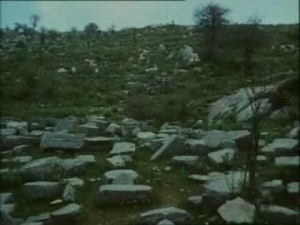 Bassae is located south of the Arcadian town of Andritsaina, on the western slopes of Kotylion Mountain and near the ancient city of Phigaleia. The mountain is scored with “vassai” (ravines), which give the place its name. In this bare, rocky landscape, 1131 metres above sea level, the people of Phigaleia founded a sanctuary in honour of Apollo. A sacred road connected the sanctuary with the city, nearly thirteen kilometres away. The sanctuary was dominated by one of the most imposing monuments of ancient Greece: the temple of Apollo Epikourios. The temple dedicated to Artemis is located in a separate sanctuary, on an upper terrace, NW of the temple of Apollo.
Bassae is located south of the Arcadian town of Andritsaina, on the western slopes of Kotylion Mountain and near the ancient city of Phigaleia. The mountain is scored with “vassai” (ravines), which give the place its name. In this bare, rocky landscape, 1131 metres above sea level, the people of Phigaleia founded a sanctuary in honour of Apollo. A sacred road connected the sanctuary with the city, nearly thirteen kilometres away. The sanctuary was dominated by one of the most imposing monuments of ancient Greece: the temple of Apollo Epikourios. The temple dedicated to Artemis is located in a separate sanctuary, on an upper terrace, NW of the temple of Apollo.The epithet “Orthasia”, “Orthosia” or “Orthia” is identified with Artemis, as she was worshipped in Sparta, from where the cult was transferred to other areas, like Bassae of Arcadia
The temple of Artemis Orthasia, protector of small children, stands in the small valley of Kotylion, at an altitude of 1.230 meters. The temple was erected in the Archaic period along with another temple dedicated to Aphrodite, next to it, possibly by poor Phigaleians from Bassae, which accounts for the poor construction technique. The finds from this area (bronze mirrors, terracotta female busts and the bones of sacrificial animals) indicate that both temples were used throughout the Archaic and Classical periods.
The temple has a cella with a pronaos, and its walls were built of roughly cut stone bonded with clay. There are no traces of columns or sculptural decoration. Like the temple of Apollo, it is orientated north-south instead of the usual east-west of ancient temples. North of the temple is a low limestone pedestal, which may have supported a cult statue. An emancipation inscription engraved on a bronze plaque, found at the temple’s southeast corner, mentions the worship of Artemis “Orthasia”, Apollo “Vassitas” and Pan “Sinois”.
 The ancient site of Lousoi is reached via the road connecting Kalavryta with Kato Lousoi village, in Achaia region. Upon arrival at Kato Lousoi, one has to take the western mountain-road towards the ancient site. Ancient Lousoi is spread on the Soudena plain, at the foot of Aroania Mountain (Chelmos), on a height of 1.200 meters. The ruins of the city are located in the woods of Prophet Elias which separates Soudena plain from the plain of Kleitoria to the south. Lousoi was an autonomous thriving ancient city until it was taken over by the Kleitorians.
The ancient site of Lousoi is reached via the road connecting Kalavryta with Kato Lousoi village, in Achaia region. Upon arrival at Kato Lousoi, one has to take the western mountain-road towards the ancient site. Ancient Lousoi is spread on the Soudena plain, at the foot of Aroania Mountain (Chelmos), on a height of 1.200 meters. The ruins of the city are located in the woods of Prophet Elias which separates Soudena plain from the plain of Kleitoria to the south. Lousoi was an autonomous thriving ancient city until it was taken over by the Kleitorians.The Austrian Institute of Athens commenced their excavations, in 1898, starting with the chapel of Panagia of Lousikon, built of ancient material from the temple of Artemis. The foundations of the temple were revealed, together with other buildings like the “bouleuterion” (assembly house), “propylon” (entrance), monumental fountain, smaller shrines and retaining walls, all dated from the 4th – 3rd century BC. The existence of an earlier temple was testified by the discovery of a fragment of the goddess’s cult statue, dated from the 6th century BC.
The new excavations have brought to light votive offerings dated from the Geometric era (end of the 8th century BC) and up to the early Classical period (early 5th century BC): a bronze scarab, bronze, silver and iron jewelry, glass and amber beads, lots of lead and bone items. Among the ceramic finds, a rare group of vessels has been found with impressed motifs of the 8th century BC. The typology of the clay figurines is of the Peloponnesian type with a typical local hair style.
The epithet “Hemera” is explained by Backchylides: the daughters of the king of Tiryns, Proitus, were cured by Melambus from insanity, with the intervention of Artemis. Out of gratitude, the princesses introduced ritual dances in honor of Artemis and founded a sacred grove where an altar was erected in order to be sprinkled with the blood of sacrificed goats and sheep. Ever since Artemis was called “Hemera” or “Hemerasia” (good willed, propitious). A big festival, called “Hemerasia” was established then, during which locals and foreigners participated in contests and races for the propitiation of the goddess. There is a plethora of ancient sources mentioning the sanctuary. Inscriptions of the 3rd century BC preserve the names of consuls and benefactors of the sanctuary. Kallimachus, in his hymn to Artemis, refers to the goddess’s temple at Lousoi. From Polybius (IV 18.9 and 34.9) we know that once, during a war, the Aetolians reached the sanctuary and after negotiations with the locals, they received a lot of the sanctuary’s treasures, as gifts in order not to destroy it. Finally, the Aetolians did not keep their word and left having committed sacrilege by catching the sacred animals of Artemis, being the sanctuary’s property.
Hermes was born in a cave, on Kyllene Mountain (the so-called Zereia today) in the region of Corinthia. His parents were Zeus and the beautiful Pleiad Maia, daughter of Atlas. Being skillful and charismatic, from birth, baby Hermes invented the first lyre and managed to steal the oxen of Apollo.
Hermes became the most talented and multi-task god: messenger of the gods, an intercessor between mortals and the divine, patron of commerce, both of legal merchandise, the random find the so-called “hermaion” and the theft item, protector of sacrificial rites, guardian angel of the crossroads and boundaries, protector of the doors of the houses and the propylaea of the sanctuaries, patron of athletics and sports and, eventually, literature, poetry and oratory, since these were taught in the gymnasia. Hermes was primarily the “psychopombos”, the conductor of souls into the afterlife.
Hermes was the most cunning and philanthropist god, beloved and amusing: the perfect expression of the virtues and defects of the ancient Greek. The rapidness, the suppleness, the alterability and the illusive paths of mind are expressed through Hermes, in an archetypal way. His chthonian (of the earth) characteristics, as a conductor of souls, were of major significance. He does not only escort the souls, but participates in the jury of the underworld, practicing duties of a chthonian deity. Actually, he was the only one of the gods, who was moving freely between the worlds, the Olympian world, the mortals and Hades.
He is depicted with his golden, winged sandals and his winged hat (“petasos”), symbol of airy speed and holding his magical golden winged staff, the “kerykeion”. The British Academic Ronald Willetts says: “…Hermes is the most congenial, unsteady, confused, complex and therefore, the most Greek of all the Olympian gods”.
His divine hypostasis derives from the roadside heaps of stone-signs of roads or tombs. Ancient farmers would add an extra stone on top of such a heap, if they came across with one, believing that a “daemon” (divinity) was dwelling in it. They called the heaps of stone “herma” and the top-stone “hermes”. Through the years, these heaps of stone were transformed into the well-known hermaic stelae which functioned as road signs and boundary markers. The fallus on them is an archetypal fertility element of the divinity.
There are not many temples built for Hermes, since he was everywhere, in almost all human performances. They felt his presence in all sanctuaries at the sacrifices, in the agoras when conducting business, in the gymnasia where they studied or exercised, in their prayers at home or in the sanctuaries, in their dreams when the word of god’s mouth reached them and in their travels –the hundreds of hermaic stelae found everywhere indicate this.
 Kato Syme is a village, of Viannos region, in the south of Heraklion County. It is located in a green valley, rich in vegetation, surrounded by a wild, imposing environment, with the Libyan Sea at the far background where Blavopotamos River flows. Here, at the site of “Krya Vryse”, a very special sanctuary of Hermes and Aphrodite has been unearthed. The excavations in the sanctuary started in 1972 and continued, sporadically, until 2003, when they stopped.
Kato Syme is a village, of Viannos region, in the south of Heraklion County. It is located in a green valley, rich in vegetation, surrounded by a wild, imposing environment, with the Libyan Sea at the far background where Blavopotamos River flows. Here, at the site of “Krya Vryse”, a very special sanctuary of Hermes and Aphrodite has been unearthed. The excavations in the sanctuary started in 1972 and continued, sporadically, until 2003, when they stopped.The sanctuary was built on a height of 1.130 meters, on the southern slopes of Dikte Mountain, being the only cult site, in Greece, up to now, which operated continuously for 27 centuries, without interruptions. The natural spring, called “Krya Vryse”, by the sanctuary, still rich in water, must have been the primary factor of the establishment of the sanctuary, far away from any ancient residential center.
The sanctuary was established in 2000 BC, in order to become a center of an outdoor worship, par excellence, where sacrifices on the “pyre”, ritual meals and “spondee” would be offered. The architectural ruins represent 13 superimposed constructive phases, through the 27 centuries. Here, we have a smooth transition of civilizations, since the periodical destructions of the monuments happened due to natural causes and not due to hostile actions. The great fame of the sanctuary is testified by the many chambers which were constructed in order to offer hospitality to priests and crowds of pilgrims. The location of the sanctuary is identified with the “Hieron Horos” (sacred mountain), described by geographer Ptolemy who puts it between ancient Tsoutsoura and Ierapytna (Hierapetra of today).
During the 2nd millenium BC, which includes all the “anaktoric” periods of the Minoan Civilization, the sanctuary functioned with a dipole scheme: a built, sheltered structure and an open-air, architecturally constructed, area for the outdoor cult. The same dipole scheme characterizes the function of the sanctuary during the 1st millenium BC, as well. It is important to note, though, that in the geometric years (9th century BC) the new architectural form of the built altar appears in the sanctuary. The outdoor cult continues. A change takes place, in the Hellenistic years (end of 4th century BC), when the outdoor rituals are transferred to a built sheltered structure. This will be the status till the decline: till the end of the Palaio-Christian age, when the indoor cult continued in the small Christian churches (4th – 7th century AD).
The finds from the excavations indicate the character of the cult and the character of the worshipped deities, as well. Generally, the cult comprises of various rites, including animal sacrifices and ritual meals. The finds, though, differ between the 2nd and the 1st millenium and represent the way that the faithful of the two millenniums perceived the divine. From the Minoan years (2nd millenium BC), anonymous ritual vessels, uniform male figurines of worshippers, absence of female figurines, give us no clue of the worshipped deity and lead to the assumption that purification rituals and spondees would be offered by crowds of Minoan male (only?) pilgrims, congregated at the sanctuary. The picture changes in the 1st millenium BC, when the Minoan ritual vessels disappear and many diverse figurines, of both sexes, appear. Additionally, many metal dedications are discovered that lead to the assumption of initiative purification rituals, connected with the dedicators’ transition from puberty to adulthood. The inscriptions (6th century BC – 2nd century AD) lead us to Hermes “kedrites”, as protector of the customs of adulthood, who was worshipped, here, together with Aphrodite. From the inscriptions we know that young people, from many parts of central and eastern Crete, were gathered in the sanctuary, together with many archons who supervised the event.
In conclusion, the focal point of the cult, in the 1st millenium BC, was an outdoor altar with a layer of pyre and bones, around it. In the ashes, most of the cult items were found and, among them, clay figurines of a naked goddess and representations of Hermes “kedrites”. Inscribed tiles bearing the dedicators’ names were found, as well. The terraces, on the slopes of the mountain, were used by the pilgrims during the festivities. Not far from the altar, a small, late Hellenistic temple, almost intact, has been found and many clay figurines, including a roman inscription which mentions Hermes and a Nikanor, son of Theomnastos.
Without doubt the sanctuary of Hermes and Aphrodite was an extra muri sanctuary, with a great fame and with the funds to be self-sustainable, perhaps supervised by the most powerful city-state of Doric Crete, each time.
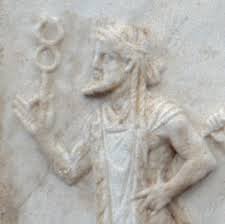 A paved asymmetric square known as the Agora of the “Hermaists” or “Competaliasts” begins, immediately after the modern quay of Delos. In the Hellenistic years (3rd – 2nd century BC), Italians began settling on the sacred island. Most of them were bankers and merchants from South Italy and Sicily. They were organized in various professional societies, each under the patronage of a god who is indicated by the name of the society.
A paved asymmetric square known as the Agora of the “Hermaists” or “Competaliasts” begins, immediately after the modern quay of Delos. In the Hellenistic years (3rd – 2nd century BC), Italians began settling on the sacred island. Most of them were bankers and merchants from South Italy and Sicily. They were organized in various professional societies, each under the patronage of a god who is indicated by the name of the society.This square was to become the center of such activities, in the 1st century BC. The Society of the Competaliasts made its appearance in the square that now bears its name. Its members were largely free men, ex slaves and slaves, under the protection of Lares Compitales, the gods of the crossroads, a roman alternative for Greek Hermes.
The square was paved with big granite slabs, many of which bear holes for the placement of poles to support shelters. It was surrounded by shops, small temples, dedicated to Hermes and altars.
Definitely, other societies would be served here as well, i.e. the Hermaists under the protection of god Hermes.
West of the agora was the ancient port. Its northern side was bordered by the Stoa of Philip and a small ionic temple, dedicated to Hermes. On the eastern and southern sides, chains of shops and workshops operated and served those professional societies. The foundations of a square and a circular building, both dedicated to Hermes and bases (exedrae) for the statues-dedications of bankers, captains and merchants, all stand in the center of the square.
Demeter, the “universal mother” of the hymns, the “blessed” and “divine”, was one of the greatest goddesses of the ancient Greek pantheon. She was the granddaughter of Gaia, the daughter of Kronos and Rhea and the sister of Zeus, Poseidon, Plouton, Hera and Hestia. As her name reveals («Demeter» comes from the Doric form “Ge” which means “Earth” and “Meter” which means “Mother”), Demeter was the goddess of cultivation and protectress of agriculture, the goddess of fertility and vegetation, being worshipped especially in rural lands: the farmers offered sacrifices to “proerosia” (before ploughing) Demeter, to “Drepaneforos” (sickle carrier) Demeter at harvest, to “Aloas” (thrashing) Demeter and, to “Chloe” (verdure) Demeter at spring time.
The cult of Demeter and her daughter Persephone (Kore) is connected, primarily, with mystic rites, the so-called Eleusinian Mysteries. These were ritual actions which focused on the “catharsis” (purification) and the exaltation of the human being. In the myth of Demeter and Kore, the imagination acquires a functional hypostasis, blended with the up-to-date experiential knowledge of things of the initiated. The initiated are transformed into beings, with an introspective psyche, yearning for a larger life and preparing for their life after death.
Apart from the Eleusinian Mysteries, the greatest festival, in honor of Demeter, were the “Thesmophoria”, on “Pyanepsion” month (middle of September to middle of October), which was held during the early sowing time. The festival was celebrated throughout Greece and was restricted to the participation of married women only. During the Thesmophoria, women abstained from sex, fasted and exchanged immodest jokes, like Baubo (Iambe), who made Demeter laugh when, in grief, she was looking for her daughter. The Thesmophoria concluded with the “Kalligeneia”, a happy feast of the participants.
Demeter’s symbols were the crane, the ear wheat, the narcissus flower, the myrtle and the crocus. The bees were her priestesses and during the sacrificial rites, bulls and honey were offered. Demeter is usually represented holding an ear of wheat and a torch.
The Latin name of Demeter was Ceres: it is from her Latin name that the word “cereals” derives (“demetriaka”, in Greek).
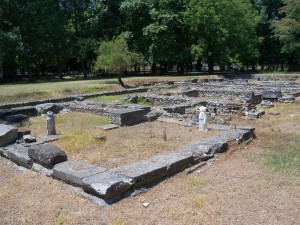 Demeter’s sanctuary at Dion is the oldest, up-to-date, known in Macedonia. It is located outside the walls of the city, very close to the gate, by the central road. Two twin temples of the sanctuary have been brought to light, together with several finds, among which a marble head of Demeter, dated from the end of the 4th century BC and a dedicatory inscription to the goddess. These twin temples were built in order to replace two older archaic temples (6th century BC), whose foundations are just behind them.
Demeter’s sanctuary at Dion is the oldest, up-to-date, known in Macedonia. It is located outside the walls of the city, very close to the gate, by the central road. Two twin temples of the sanctuary have been brought to light, together with several finds, among which a marble head of Demeter, dated from the end of the 4th century BC and a dedicatory inscription to the goddess. These twin temples were built in order to replace two older archaic temples (6th century BC), whose foundations are just behind them.The older archaic temples had the form of a “megaron”, made of mud brick and stones. Wooden benches, in the interior, were used for the placement of the various dedications of the faithful.
The 4th century twin temples were doric in style and housed the cult statues whose bases are still in situ. Demeter’s marble head was found on one of these bases. The altars are located in front of the temples, on the eastern side. These temples, being the focal point of the sanctuary, were framed with smaller single-chamber cult structures (“oikos”), housing cult statues and stone offering tables for the first annual crops.
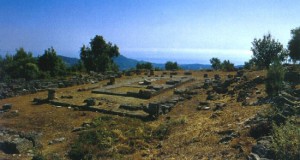 Lepreon was an important ancient city of the region of Elis which played a major role in controlling ancient roads and passages, leading to Messenia and Arcadia. The city was spread between the rock of its acropolis, north of the modern village and the hill, where the Neolithic settlement was first built. The temple of Demeter was built in the classical age, within the acropolis of Lepreon.
Lepreon was an important ancient city of the region of Elis which played a major role in controlling ancient roads and passages, leading to Messenia and Arcadia. The city was spread between the rock of its acropolis, north of the modern village and the hill, where the Neolithic settlement was first built. The temple of Demeter was built in the classical age, within the acropolis of Lepreon.The temple is built on a terrace, on the lower part of the acropolis, offering views towards the Ionian Sea, the Valley of Neda River and the temple of Epicurius Apollo, at Vassae. It is described by Pausanias, as a mud brick structure, without any cult statue inside it.
It is a doric “peripteral” (with a surrounding colonnade) temple, with 6 x 11 columns. It has a “pronaos” (front chamber) with columns in antis, a cella without inner colonnade and no “opisthodomos” (back chamber). It is built of shelly stone, which was used for the fortification wall, as well. Parts of the foundations of the colonnade and the cella, together with many architectural fragments (drums, capitals of columns, simae) are in situ. Traces of white coating can be seen on the fragments of the columns. Based on its architectural elements and styles, the temple is dated from the early 4th century BC. It is built over an older one, whose traces can be seen in the interior.
The altar has been located 7 meters away from the temple façade. It is a rectangular shelly stone structure (5 x 1,5 meters).
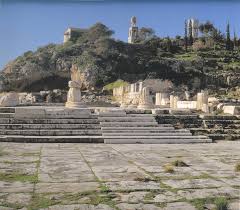 Ancient Eleusis was an important “demos” (municipality) of the city-state of Athens. It was located between two valleys, called “Thriasion” and “Rarion” and the Eleusinian bay at the Saronic Gulf, at a distance of 20 kilometers away from the center of ancient Athens. The famous Sacred Road (Iera Odhos) connected the Sacred Gate of Athens with the entrance of the Eleusinian sanctuary. The whole course of the Sacred Road was followed, on foot, by the initiates, during the Eleusinian Mysteries.
Ancient Eleusis was an important “demos” (municipality) of the city-state of Athens. It was located between two valleys, called “Thriasion” and “Rarion” and the Eleusinian bay at the Saronic Gulf, at a distance of 20 kilometers away from the center of ancient Athens. The famous Sacred Road (Iera Odhos) connected the Sacred Gate of Athens with the entrance of the Eleusinian sanctuary. The whole course of the Sacred Road was followed, on foot, by the initiates, during the Eleusinian Mysteries.The sanctuary is located at the eastern part of Eleusis, near the ancient harbor: a sanctuary of Panhellenic fame, dedicated to the cult of Demeter, which was introduced in the Mycenaean age (1409 BC). According to the tradition, Demeter, while in search of her kidnapped daughter, whom the god of Hades, Plouton, had taken into his underworld realm, reached Eleusis. There, she received a great hospitality by king Keleos. After the recognition of her divinity, Demeter taught the art of cultivation to the locals and ordered a temple to be built on a specific outcrop of the hill, which she indicated: today, this spot is within the ruins of the “Telesterion”. Ever since, the presence of the goddess was connected with Eleusis and the cultivation of the earth. The rites, in her honor, had a mystic character and were open only to the initiates. The penalty of revealing the divine secrets was death. Due to this, today, we know very little of the re-enactments or the process of initiation.
The sanctuary was in use for over one thousand years, starting from the Mycenaean age, until its destruction by the Visigoths of Alarichus, in 395 AD.
The focal point of the sanctuary was the central chamber (Telesterion) which was dedicated to Demeter, as per her indication. The Telesterion underwent many restorations and ended as a large square chamber, with a roof supported by inner columns, made of light blue Eleusinian limestone. The initial cult chamber was, at all times, incorporated in every new restoration of the Telesterion. About 9 different restoration phases took place until the 2nd century AD, starting with the Peisistrateian (6th century BC) enlargement of the cult chamber (early Telesterion) and the construction of a fortification wall. Another important restoration took place after the Persian Wars (5th century BC) in the years of Kimon, followed by that of Pericles, when the Telesterion was very much enlarged.
In the 4th century BC, a monumental, marble entrance (“prostoon”) was added on the eastern façade of the Telesterion. The acropolis, on the west, was fortified as well, making Eleusis one of the most important and powerful fortresses of the city-state of Athens. It was here, among other fortresses, where the young Athenian men (“epheboi”) would do their army service for two years.
During the roman times, Eleusis –just like Athens- received the favour of Rome, since many of its emperors had been initiated in the Eleusinian Mysteries. The Romans took care of the whole area, thus many ruins survive, today, from that age.
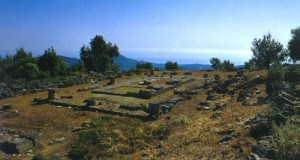 The sanctuary of Demeter and Kore was a major cult center of ancient Corinth and one of the largest in Greece. It is located south of the ancient city center, at the foot of the huge rock of Acrocorinthos, the citadel of the ancient city.
The sanctuary of Demeter and Kore was a major cult center of ancient Corinth and one of the largest in Greece. It is located south of the ancient city center, at the foot of the huge rock of Acrocorinthos, the citadel of the ancient city.At its initial phase of construction (either archaic or classical), the sanctuary was crossed by a staircase which led to several dining rooms. The central cult area was composed of a court with a small temple (“oikos”) and a leveled terrace bearing the altar, for the sacrifices. On a later phase (end of the 4th century BC), the sanctuary is rearranged: access became possible through a doric “propylon” (columned entrance), the temple was transferred to an outcropping of a rock, the area of the old temple was transformed into a stoa, while a small theater, of a capacity of 100 people, was built.
The sanctuary survived until the total destruction of Corinth, in 146 BC, by the troops of the Roman general Mommius. Only after the establishment of the roman colony, in the 1st century BC, the sanctuary is re-used: during the roman restorations, the dining rooms and the staircase were covered, the propylon was enlarged and 3 small ionic temples were built. A mosaic floor was found in the central temple. One of the dining rooms, which ended up below the propylon, was converted into a roman cult chamber where “katadesmoi” (written curses) were placed. The sanctuary was abandoned in the end of the 4th century AD and, gradually, from the 6th century onwards, a Christian cemetery occupied a great part of it.
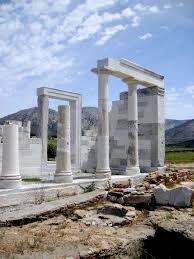 A rural, open-air, cult of earth deities started to be practiced in the 8th century BC, on a mound overlooking a fertile valley. Today, this area is called “Gyroulas”, located south of Sangri village. On the very spot of this open-air cult, a monumental marble temple was erected, later in the late 6th century BC.
A rural, open-air, cult of earth deities started to be practiced in the 8th century BC, on a mound overlooking a fertile valley. Today, this area is called “Gyroulas”, located south of Sangri village. On the very spot of this open-air cult, a monumental marble temple was erected, later in the late 6th century BC.The sanctuary was dedicated to god Apollo, goddess Demeter and Kore and the cult focused on their “chthonian” (earthen) characteristics.
The cult of chthonian deities who are related to fertility and the growth of vegetation can be explained from the creation of such a sanctuary, in the midst of a farming land. The sanctuary became a great center of worship and major factor of social cohesion, in the whole area.
The marble temple represents an important step in the evolution of Greek architecture. During the early Christian era (5th -6th century AD), the temple was converted into a basilica. Until the 8th century AD, when the area was abandoned, various workshops were developed around the basilica, for the production of olive oil, wine and ceramics. Later, the worship was continued in a small one-chamber chapel, dedicated to Saint John the Theologian, erected under the Holy Bema of the ruined basilica. In 1977 and due to the needs of the restoration works, the chapel was relocated, thus brought to its modern position.
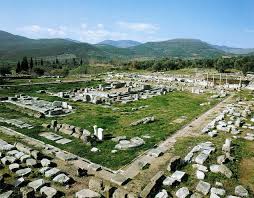 Messene was an important ancient city which was founded in 370 BC, by the Theban general Epameinondas, after his victory against the Spartans, in the battle of Leuctra. Epameinondas freed the region of Messenia and decided to build the city of free Messenians, at an area just beyond the foot of Ithome hill. Today, at a distance of 500 meters, west of Mavrommati village, one can enter the archaeological site, where the ruins of this ancient city, Messene, are located.
Messene was an important ancient city which was founded in 370 BC, by the Theban general Epameinondas, after his victory against the Spartans, in the battle of Leuctra. Epameinondas freed the region of Messenia and decided to build the city of free Messenians, at an area just beyond the foot of Ithome hill. Today, at a distance of 500 meters, west of Mavrommati village, one can enter the archaeological site, where the ruins of this ancient city, Messene, are located.
To the SW end of the Agora, next to the Asclepion, a sacred building has been discovered (24×24 meters). Inside the building, the foundations of a cult structure were found, dated from the 4th-3rd century BC, together with other structures, serving as annexes. A great number of terracotta votive plaques and figurines were found beneath the floor of the main building, where they had been thrown along with fragments of pottery and animal bones in hollows (“apothetes”) in the bedrock. A wide variety of subjects is depicted on them, including funerary banquets, horsemen, seated or standing female or male figures, warriors, and three frontal female figures.
Pausanias (4.31.10) mentions “a holy sanctuary of Demeter” and “statues of the Dioskouroi in Messene” which should be located on this very spot, according to his descriptions.
The sanctuary of Demeter is also mentioned on a “construction inscription” for buildings to be repaired. This inscription was found in the Sebasteion and dates from the years of Emperor Tiberius.
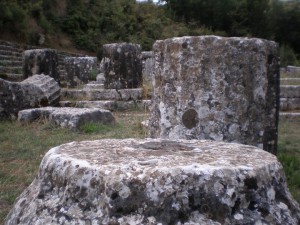 The village called “Demetra” or “Divritsa” (land of many waters) is located in the region of Gortynia, in Arcadia, on a height of 660 meters, between the villages of Kondovazaina and Vachlia. It is surrounded by the hill of Prophet Elias, on the north and Dariza Mountain, on the south. The village, called Demetra, owes its name to the ancient sanctuary of Demeter which was built there, in which the goddess was worshipped as Demeter “Eleusinian” or “Alousia”.
The village called “Demetra” or “Divritsa” (land of many waters) is located in the region of Gortynia, in Arcadia, on a height of 660 meters, between the villages of Kondovazaina and Vachlia. It is surrounded by the hill of Prophet Elias, on the north and Dariza Mountain, on the south. The village, called Demetra, owes its name to the ancient sanctuary of Demeter which was built there, in which the goddess was worshipped as Demeter “Eleusinian” or “Alousia”.Demetra is a “revelation” village of mountainous Arcadia, beautifully situated by Ladon River. Demeter had passed from there, while in search for her daughter. During Pausanias’ days (2nd century AD), the sanctuary was in a very good state of preservation, while, today, just a few fragments are surviving.
 Today, on the northern slopes of Parnassus Mountain, the modern village of Polydrosos, offering views towards the valley of the Boeotian Kephisos River, occupies the area of the ancient city of Lilaia.
Today, on the northern slopes of Parnassus Mountain, the modern village of Polydrosos, offering views towards the valley of the Boeotian Kephisos River, occupies the area of the ancient city of Lilaia.In the classical years and after the Persian Wars (5th century BC), Lilaia thrives and due to the great increase of its population, a near-by hill, next to the springs of the city, is occupied for a newly built suburb, given the poetic name “Erochos”.
The rural sanctuary of Demeter is built, here, in Erochos, right away (5th century BC).
The sanctuary was discovered in 1928, when a dedicatory stele was found, with the inscription ΜΝΑΣΙΚΛΕΣ ΔΑΜΑΤΡΙ ΚΑΙ ΚΟΡΑΙ (MNESIKLES TO DEMETER AND KORE), dated from the 4th century BC.
The sanctuary consists of an exterior, 80-meter wall and an inner, shorter 45-meter one. Between the two walls, there many rooms where lots of dedications have been found: clay figurines of the 5th century BC, coins of various cities from the 4th century BC, jewelry and other. The roof was covered by tiles constructed in a potter’s workshop of Lilaia, with the incision: ΛΙΛΑΙΕΩΝ (LILAION). Added to this, another find indicated the character of the cult in the sanctuary. It is a bronze vessel, bearing the inscription of the 5th century BC: ΔΑΜΑΤΡΙ ΕΝ ΕΡΩΧΟΙ (TO DEMETER IN EROCHOS).
The sanctuary was destroyed in the end of the 4th century BC and was reused, for a while, until its final destruction in the late Hellenistic age. No roman traces have been found during the excavations.
Today, all the finds from the sanctuary are displayed in the Archaeological Museum of Amphissa.
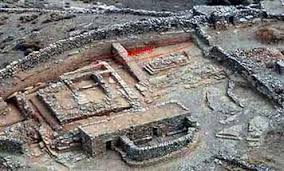 In the middle of the west coast of the island, on the Vryokastron peninsula, the ancient city of Kythnos is located. On the highest peak of the peninsula, the ruins of a sanctuary of a female deity have been observed. The area has not been excavated yet.
In the middle of the west coast of the island, on the Vryokastron peninsula, the ancient city of Kythnos is located. On the highest peak of the peninsula, the ruins of a sanctuary of a female deity have been observed. The area has not been excavated yet.The large number of finds, found on the surface, especially on the NE slope of the acropolis, led us to the certainty that they belong to a sanctuary dedicated to Demeter. Additionally, lots of architectural fragments are scattered around, belonging to two rectangular temple-like structures, two altars and two other buildings.
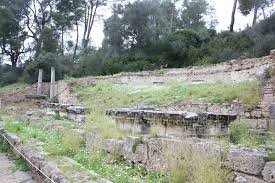 Demeter “Chamyne” (sitted on the ground) is an old chthonian goddess. Her sanctuary has been identified with the ruins on the asphalt road crossing the archaeological site of Olympia. It is dated from the 6th-5th century BC and was tightly connected with the cult practiced in Olympia.
Demeter “Chamyne” (sitted on the ground) is an old chthonian goddess. Her sanctuary has been identified with the ruins on the asphalt road crossing the archaeological site of Olympia. It is dated from the 6th-5th century BC and was tightly connected with the cult practiced in Olympia.Clay and bronze vases, bearing inscriptions are among the finds. The most interesting find, which identified the sanctuary with the cult of Demeter, is a figurine with an inscription mentioning Demeter, Kore and the king of the underworld, Ades. Pausanias mentions the existence of this sanctuary.
One theory supports that the Olympic Games were initially based on the fertility of the earth and vegetation, characteristics of Demeter Chamyne. The goddess was definitely related to the games, since the only female presence, at the stadium, was the priestess of Demeter “Chamyne”, who was sitted next to the stone altar, on the side of the stadium. It is possible that the races, in the stadium, were held in her honor.
It should be noted that during the roman times, Regilla, the wife of Herodes Atticus had this title.
Poseidon has been praised, by the Orphic poets, as “gaieochos” –he, who possesses the earth- and “kyanochaites” -he, who has an azure mane, thus possesses the sea. He was the god who “inhabited the foundations of the ocean” and would strike his trident, causing earthquakes and waves. He was the “stirrer of the earth” according to Homer.
Poseidon was the son of Kronos and Rhea and, together with others, the brother of Zeus. Whenever he was not on Olympus, he dwelt in his palace in the depths of the ocean, with his wife, the Nereid Amphitrite. One tradition says that he was raised in Rhodes, where he met Alia, sister of the Telchines, and had six sons and one daughter, called Rhode. The island of Rhodes had Rhode’s name. He was also the father of Theseus but also of Prokroustes, Skiron and the giants: the twins Otos and Ephialtes, Tityos and Orion. He had tamed the first horse (“hippos”) and was the father of winged Pegasus, from his union with Medusa.
His symbols were the fish and especially the dolphin and the “hippos” (horse), thus his epithet as “Hippios”. And, as Socrates says, in “Kratylos”, “Poseidon is posidesmos, since he ties up the feet of the mortals, depriving them of using their logic and forcing them to use their emotions which he controls”. “Hippodromies” (chariot races) would take place in all festivals in honor of the god, for whom the galloping horses shake the earth. Poseidon was the protector of the sailors to whom they sacrificed, before sailing or during the trip, for safe travelling.
Poseidon symbolizes the perpetual motion and the fluidness –just like the nature of the liquid element and, consequently, the world of emotions. Our emotions are never static, being always transformed according to the circumstances and the environment. There is a reason why the illnesses of the psyche were attributed to this great god who “moves” the human sentiments with his trident, just like the way he does it with the waves of the oceans.
According to Pausanias, Poseidon was one of the guardians of the oracle of Delphi, before Apollo. Apollo and Poseidon functioned side by side on many levels, i.e. colonization: the Delphian Apollo provided colonists with his “agreement”, while Poseidon provided them with his “purification water” for the sacrificial ceremony of their establishment in the newly founded colony. We find another connection between the two gods, In Xenophon’s “Anabasis”, a group of soldiers would sing a “paean” (400-399 BC), which was actually a hymn, sang for Apollo.
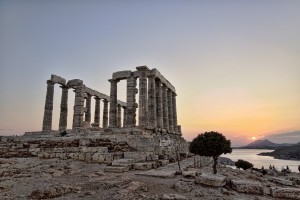 Sounion was an important “demos” (municipality) of the ancient city-state of Athens. The sanctuary of Poseidon occupies the top of the promontory of Sounion, offering views towards the Cyclades. The sanctity of the site is testified by Homer, since the 8th century BC. During the archaic age (7th-6th century BC) the sanctuary was already thriving, but its monumental formation was to come later, in the classical era.
Sounion was an important “demos” (municipality) of the ancient city-state of Athens. The sanctuary of Poseidon occupies the top of the promontory of Sounion, offering views towards the Cyclades. The sanctity of the site is testified by Homer, since the 8th century BC. During the archaic age (7th-6th century BC) the sanctuary was already thriving, but its monumental formation was to come later, in the classical era.During the excavations, a great quantity of dedications were discovered, buried in ancient “apothetes” (sacred dumping holes), which were gathered after the destruction of the sanctuary by the Persians, in 480 BC. The porous stone temple that was being built, during the Persian invasion, was destroyed as well. Years later, in 444 – 440 BC, a new temple was built whose ruins are still visible on the rock. It is a Doric temple, made of local marble from the near-by Agrileza rocks. The pediments were crowned by anthemia and, at least, the eastern one was decorated with statues. Its frieze was made of Parian marble and depicted scenes from the Centauromachy and the exploits of Theseus: an allegory of the victory of the Greeks against the Persians, in other words, an allegory of the supremacy of the Athenian Democracy versus the Persian despotism of the time. The temple is attributed to the same architect who designed the Hephaisteion of the Agora of Athens, the temple of Ares at Acharnes and the temple of Nemesis at Rhamnus.
A glorious festival was held in the sanctuary of Poseidon, every four years, during which the official guests sailed to Sounion, on the “Theoris” boat, just like they did to the sanctuary of Apollo on Delos. The whole temenos occupies an area of 5 acres. It was surrounded by a wall and was accessible through a monumental propylon, on its NE side. The temple stands out, on the southern side of the sanctuary, while, two stoas stand on the NW side of it.
The sanctuary of Poseidon thrived from the 5th century BC until the early Christian years, following the rise and decline of the ancient religion. Then, it was abandoned and, eventually, ruined. Today, the standing “kavokolones” (cape columns), on the top of the rock and seen from a distance, are still a symbol of the power of the god of the sea: Poseidon!
 Poros is a volcanic island, at the SW of the Saronic Gulf, by the SE coast of the Argolis peninsula. Due to geo-tectonic activities, Poros comprises of the main island, the so-called ancient “Kalavria” and a small, single volcanic rock, the so-called ancient “Sphairia”, separated from Kalavria, by a natural, narrow canal. As the myth determines, Kalavria, at first, was offered to god Apollo who made it over to god Poseidon, in return for Delphi. Kalavria was the ancient name of both the island and the main city. Such was the place’s importance, that it functioned as the center for the Amphictyonic League (“amphictionnes”: dwellers around), a “cooperative” of city-states, in both civic and religious matters, which included the ancient cities of Hermione, Epidauros, Aegina, Prassies, Athens and Arcadian Orhomenos.
Poros is a volcanic island, at the SW of the Saronic Gulf, by the SE coast of the Argolis peninsula. Due to geo-tectonic activities, Poros comprises of the main island, the so-called ancient “Kalavria” and a small, single volcanic rock, the so-called ancient “Sphairia”, separated from Kalavria, by a natural, narrow canal. As the myth determines, Kalavria, at first, was offered to god Apollo who made it over to god Poseidon, in return for Delphi. Kalavria was the ancient name of both the island and the main city. Such was the place’s importance, that it functioned as the center for the Amphictyonic League (“amphictionnes”: dwellers around), a “cooperative” of city-states, in both civic and religious matters, which included the ancient cities of Hermione, Epidauros, Aegina, Prassies, Athens and Arcadian Orhomenos.Poseidon’s sanctuary was built on a height of 190 meters above the sea, near the ancient city. The sanctuary was a prestigious center of Panhellenic worship and, being the seat of the Amphiktyone of Kalavreia, served as an “asylum”. It was here where the famous orator Demosthenes retreated and died in 322 BC (Strabo 8.6.14). This large temenos (cult place) has yielded material remains of long-lived and multi-faceted cult activity, from possibly prehistoric to late antique date. The Doric temple was built in 520 BC (end of archaic age). The sanctuary was extended towards the south, in the end of the 4th century BC, with the construction of buildings C, D and the propylaea. Its use continued till the late roman years.
The area was excavated by the Swedish archaeologists Samuel Wide and Lennart Kjellberg in 1894 – the first Swedish excavation in Greece. In their early publication (Athenische Mitteilungen 1895), they focus on the dating of the architectural ruins. The richness of the Mycenaean pottery, found inside the temple, led them to the belief that the establishment of the Amphictyonic League took place in the 2nd millenium BC. This is a theory that has been under question. New excavations started in 1997 by the Swedish Institute of Athens.
 The archaeological site is located 4 kilometers west of Kalamata and 500 meters south of modern Akovitika. It comprises of two excavated areas, 200 meters apart from each other, both by the banks of Aris River.
The archaeological site is located 4 kilometers west of Kalamata and 500 meters south of modern Akovitika. It comprises of two excavated areas, 200 meters apart from each other, both by the banks of Aris River.The ruins were revealed in 1968, during flood prevention works, at the banks of the river and during the excavations of the following years. They belong to two groups: the first group comprises of two large, early Helladic buildings of the “megaron” type (3rd millenium BC) and the second group belongs to the buildings of the sanctuary of Poseidon, 200 meters further to the south.
In the sanctuary of Poseidon, archaeologists have dug up the northern side of a rectangular structure, with an inner atrium and an exterior Doric-columned arcade that surrounds the building. A long, narrow corridor, with wooden columns, enclosed the arcades from the exterior. A small well, made of limestone, was found in the interior. The building must have been roofed by tiles of the “laconic” type, with the sign ΔΑΜΟΣΙΟΣ (DAMOSIOS), which means “public”, indicating the character of the building. The building is dated from the 6th century BC, but there is evidence of an earlier phase of construction (late 7th century BC). Among the finds, iron models of equipment from boats and ships, as well as a bronze fish hook, have led scientists to believe that the sanctuary was built by sailors as tribute to the god of the sea, Poseidon, a fact confirmed by an inscription written on the body of a clay vessel.
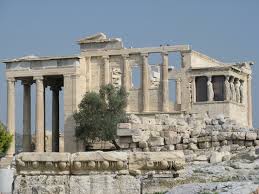 The elegant building known as the Erechtheion, on the north side of the sacred rock of the Acropolis, was erected in the classical age (421-406 BC) as a replacement of the earlier “old temple” which was dedicated to Athena “Polias” (goddess of the “polis” or city).
The elegant building known as the Erechtheion, on the north side of the sacred rock of the Acropolis, was erected in the classical age (421-406 BC) as a replacement of the earlier “old temple” which was dedicated to Athena “Polias” (goddess of the “polis” or city).The name ”Erechtheion”, mentioned only by Pausanias (1.26.5), derives from Erechtheus, a mythical king of Athens, who was worshipped after his death as a hero-ancestor. Other texts refer to the building simply as ”old temple”. The building owes its unusual shape to the irregularity of the terrain – there is a 3-meter difference, in height, between the eastern and western parts- and the multiple cults it was designed to accommodate. The eastern part of the building was dedicated to Athena “Polias”, while the western part served the cult of Poseidon-Erechtheus and also held the altars of god Hephaestus and Voutos, brother of Erechtheus. Added to these, the Erechtheion was the dwelling place of goddess Athena’s sacred snake, the so-called “Erichthonios” and the shelter for the grave of Kekrops, the first heroic king of the city. When the monument was being built, the architects took care not to “disrupt” the holy traces of the dispute between Athena and Poseidon for the patronage of the city.
The temple was made of Pentelic marble, the frieze of Eleusinian grey stone with white relief figures attached to it and the foundations of Piraeus stone. On its eastern side, an Ionic portico with six columns sheltered the eastern entrance of the building. The cult statue of Athena stood in the interior, made of olive wood, which the “Arrhephoroi” (young Athenian priestesses) draped with the sacred peplos, during the Panathenaic festival. On the northern side, one can see the entrance to the western part of the building, sheltered by a Greek pi-shaped propylon, with four Ionic columns along the facade and one, on either side. The stone paving of this propylon was thought to preserve the traces made by Poseidon’s trident, when it hit the ground and brought sea water to the surface. Under the temple’s floor and according to tradition, there was ”Erechtheis Sea” where Poseidon’s sea waters gathered. A small door on the western side led to the near-by sanctuary of Pandrosos (king Kekrops’ daughter). Four Ionic columns on a high stylobate, with metal railings between them, adorned the west facade. Finally, another door on the southern facade of the western temple opened onto the porch of the Karyatides, a Greek pi-shaped structure, a kind of veranda porch with six female statues, supporting the roof, instead of columns. They were created by Alkamemes or Kallimachos and were called, initially, “korae”. Later, in the roman era, they called them “Karyatides”, after the young women from Karyes of Lakonia, who were renowned for their beauty and used to dance in honour of the goddess Artemis. Five of them are in the Acropolis Museum and the sixth in the British Museum, thus the ones standing in situ, today, are old casts.
The temple was burned in the 1st century BC and was, subsequently, repaired with minor alterations. In the Early Christian period it was converted into a church dedicated to the “Theometor” (Mother of God). It was converted into a palace, during the Frankish rule and, later, into a residence for the Turkish commander’s harem, during the Ottoman occupation. In the early 19th century, Lord Elgin removed one of the Karyatides and a column and during the Greek War of Independence the building was bombarded and severely damaged. Restoration was undertaken immediately after the end of the war and again in 1979-1987, when the Erechtheion became the first monument of the Acropolis to be restored, as part of the recent conservation and restoration project. Its restoration received the Europa Nostra award.
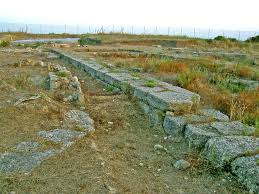 Poseidi is a summer resort at the promontory of the peninsula of Cassandra, in Chalkidiki. In the near-by area, traces of ancient Mendi, an Eretrian colony of the 8th century BC, have been found. The ancient city was well known for the production of the famous “mendian” wine.
Poseidi is a summer resort at the promontory of the peninsula of Cassandra, in Chalkidiki. In the near-by area, traces of ancient Mendi, an Eretrian colony of the 8th century BC, have been found. The ancient city was well known for the production of the famous “mendian” wine.Not far from the ruins of the Mendi, at Poseidi, an important sanctuary of Poseidon was excavated, comprising of a classical temple (5th century BC), two buildings (7th-6th century BC), on both sides of it and an early-geometric apsidal building (11th century BC), which is the oldest. All buildings were sacred, bearing altars for sacrifices and sacred spaces for ceremonies. The sanctuary operated for more than 1000 years, and there are references about it in Thucydides and in Mount Athos documents of the 14th century. Probably it was built by the Eretrian colonists, who stayed at ancient Mendi and worshipped Poseidon as their protector.
The lighthouse, which is still standing at the edge of the promontory, was built in 1864 (19th century).
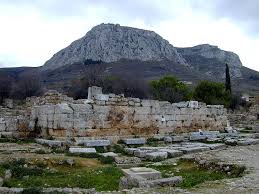 At Isthmia, northeast from ancient Corinth and very close to the isthmus, connecting the mainland of Greece with the Peloponnese, there stand the ruins of the sanctuary of Poseidon. The Sanctuary became a major extramural shrine of the Corinthians, their most important religious foundation outside the city. It was one of four sanctuaries where Greeks from all parts of the Mediterranean came to compete in Pan-Hellenic games.
At Isthmia, northeast from ancient Corinth and very close to the isthmus, connecting the mainland of Greece with the Peloponnese, there stand the ruins of the sanctuary of Poseidon. The Sanctuary became a major extramural shrine of the Corinthians, their most important religious foundation outside the city. It was one of four sanctuaries where Greeks from all parts of the Mediterranean came to compete in Pan-Hellenic games.The first traces of the temple are dated from the 7th century BC and belong to the tiles of its roof and to a marble “perirrhanterion” (fount). In the 5th century BC (470 – 460 BC) the whole area of Isthmia was destroyed by fire and a new temple is rebuilt, as a Doric “peripteral” (with a surrounding colonnade) from local limestone. The “pteron” (colonnade) had 6×13 columns and a “stylobate” of 54×23 meters. It had marble tiles with beautiful marble spouts in the form of lion heads. Another fire, in the spring of 390 BC, destroyed the sanctuary, during the war between the king of Sparta Agesilaus and the troops of the Corinthians. The temple was restored and the marble tiles were replaced by ceramic ones. The sanctuary continued thriving till the destruction of Corinth by the roman troops of Mommius, in 146 BC. After the establishment of the roman colony, over the ruins of the ancient city, by Julius Caesar and during the reign of Tiberius, the sanctuary of Poseidon was totally rebuilt.
After its last destruction by an earthquake (4th century AD) and the decrees against the use of ancient temples issued by emperors Theodosius A’, Arcadius and Theodosius B’, the temple of Poseidon was abandoned. Eventually, the ruins of the sanctuary became a quarry of ready-made blocks of building material. It was actually reused by the general of Justinian’s army, Victorinos, who was in charge of the construction of a fortification wall, across the isthmus, the so-called “hexamillion”. Such walls and fortresses, all around Greece, were part of the great-scale defensive project of emperor Justinian, across the Byzantine Empire.
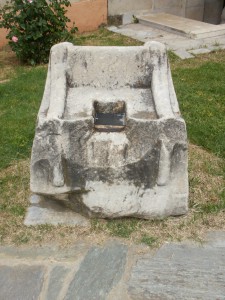 The sanctuary of “Hippios” Poseidon, in ancient Mantineia, was of great importance for the Arcadians, who worshipped Poseidon as one of their great gods. Most of the epithets of the god describe his impetus. They called him “Holetera” (he, who blends), “Mochlotera” (he, who prizes) and “Hippio” (horse-like). Being the god of the earthquakes and waters, he is connected with the proud horses, sensitive in under-earth currents and powers.
The sanctuary of “Hippios” Poseidon, in ancient Mantineia, was of great importance for the Arcadians, who worshipped Poseidon as one of their great gods. Most of the epithets of the god describe his impetus. They called him “Holetera” (he, who blends), “Mochlotera” (he, who prizes) and “Hippio” (horse-like). Being the god of the earthquakes and waters, he is connected with the proud horses, sensitive in under-earth currents and powers.The sanctuary is located on the SE of the ancient city of Mantineia, next to Arne spring, where the god was born. The temple of the sanctuary was an Abaton. Once a year, the priest who served in the sanctuary, would perform the mystic rites in honor of Poseidon, away from the eyes of the people. The temple was built by the Boeotian architects, Trofonios and Agamedes, who had the fame of building temples only for the immortals. It was ruined during the roman times, so Emperor Hadrian who visited Mantineia, in 130 AD, decided to restore it.
The ruins of the sanctuary were discovered by the French archaeologist Fougeres, who worked in the Arcadian land, followed by the Greek archaeologist Spyropoulos. Today, among the ruins, one can see the foundations of the temple, a group of sacred chambers and bases of pillars. A Byzantine cist grave indicates the use of the area by a local landholder. Additionally, an ancient aqueduct and lots of inscriptions were brought to light.
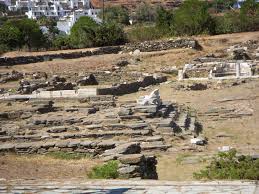 Kionia houses one of the most important sanctuaries of Poseidon on the Cyclades. It was a sanctuary, tightly connected with life in the ancient city of Tinos, from the 4th century BC onwards. In fact, Tinos was the only island of the Cyclades that has dedicated an entire sanctuary to Poseidon only. Along with him, his wife, the sea nymph Amphitrite, was also worshiped. God Poseidon, being the god of purifying and healing water, was worshipped as a doctor as well. Specifically, during the Hellenistic years, a burst of the cult of hero-doctors is observed.
Kionia houses one of the most important sanctuaries of Poseidon on the Cyclades. It was a sanctuary, tightly connected with life in the ancient city of Tinos, from the 4th century BC onwards. In fact, Tinos was the only island of the Cyclades that has dedicated an entire sanctuary to Poseidon only. Along with him, his wife, the sea nymph Amphitrite, was also worshiped. God Poseidon, being the god of purifying and healing water, was worshipped as a doctor as well. Specifically, during the Hellenistic years, a burst of the cult of hero-doctors is observed.Towards the end of the 4th century BC, the heirs of Alexander the Great, and especially the Macedonian royal houses of the Antigonidae and the Lagidae, hold the fate of the Cyclades in their hands and organize building programs. This is testified by the emblematic Macedonian star which decorates the ceiling panels of the fountain of the sanctuary.
The 4th century BC is the age when the ancient city appears on the site of the modern town of Tinos, simultaneously with the first monumental buildings in the sanctuary, at modern near-by Kionia. Kionia was a kind of relief anchorage for sailors, who stopped there, when, on their way to sacred Delos, in order to offer sacrifices to the god of the sea for safe travelling through the rough waves of the pass between the two islands. The huge cult statues of Poseidon and Amphitrite were kept inside the temple. On a yearly basis, between January and February, religious ceremonies known as “Poseidonia” were celebrated in honour of the god. The festival attracted people from all around Greece, where they would attend theatrical contests and participate in sacred rites and sacrifices. The cult of Amphitrite was established at the same period. She was worshipped for her healing powers to women who could not have children. The sanctuary had the same fame with the Asclepion of Epidaurus and was regularly visited by hundreds of people. The natural environment contributed to this fame since the sanctuary was built in a peaceful, idyllic grove, by the sea.
The Doric temple and the other buildings of the sanctuary were embellished by some local inspired works, like the fountain-exedra. Local marble and gneiss stones have been used, in a variety of colors. Famous ancient sculptors were invited to work on the project like the Athenian Telesinus, the Ephesian Agasias and the Macedonian Andronikos who constructed the famous sun clock which is displayed in the Archaeological Museum of the island.
When Delos became a free port, in the end of the 2nd century BC, the sanctuary at Kionia was restored, acquiring a great stoa and a monumental altar. The temple was so famous that Strabo (1st century AD) describes it as “great and worth seeing”. It had become known in Italy and Asia Minor. The decline comes, gradually, from the roman times till the 3rd century AD, when the sanctuary is abandoned. A kiln operates over the ruins which had been transformed into a quarry of building material. In the 4th century A.D, when Christianity was established as a religion, the temple was destroyed.
Kionia area was first excavated in 1902 and 1905 by the Belgian archaeologists H. Demoulin and P. Graindor respectively. Apart from the main temple, the archaeological site includes baths, an altar, a monumental stoa and a fountain. Some of the finds of the excavations are displayed in the Archaeological Museum of Tinos.
The so-praised, by the Orphic hymn, as «airy-formed» and “queen of all” goddess Hera, who became the “blessed consort” of Zeus, was the daughter of Kronos and Rhea. For Homer, she was raised by Oceanus and Tethys, while others believed that it was Temenos, the son of Pelasgos, who had raised her or the Horae. Being the goddess who was “mixed with venerable air”, she was born on many lands: Samos, Argos, Euboea and Arcadian Stymphalos.
The “Tonaia” festival was celebrated every year, in her honor, on the island of Samos. During the rituals, her cult statue was carried to the beach for purification and sweet offerings were placed in front of it. And, as the poet says, “she tosses and turns in the rushing wind and bathes in the waters”: this is the moment of her ritual annual purification bath. The participants to the rites wore wreathes of wicker and laurel. Other divine plants, with which the goddess was connected, were the pear tree –her cult statue, in her sanctuary of Argos, was made of pear wood- the helichrysum, the pomegranate and the lily. Her animal-symbol was the peacock.
For three hundred years, Hera was having a secret love affair with Zeus in a hidden place on mountain Kitheron, away from their parents. Zeus had sneaked in her hug, in the form of a cuckoo. The poet Kallimachus mentions Samos as the land of their first intercourse. For others, their marriage took place on the open ocean.
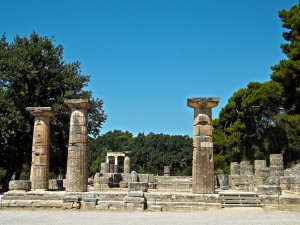 Today, the temple of Hera stands, gracefully, near the temple of Zeus, at the northwest corner of the sacred grove (“Altis”) of Olympia, below Kronion hill. The temple went under several slow constructive phases, through the years, ending up as a “museum” during the roman times: it was then, when important artifacts were stored or exhibited there, with Hermes of Praxiteles among them.
Today, the temple of Hera stands, gracefully, near the temple of Zeus, at the northwest corner of the sacred grove (“Altis”) of Olympia, below Kronion hill. The temple went under several slow constructive phases, through the years, ending up as a “museum” during the roman times: it was then, when important artifacts were stored or exhibited there, with Hermes of Praxiteles among them.The temple had the form of a long structure, with a comparatively low height. Like most of the ancient Greek temples, it has an orientation E – W, with the façade on the eastern side. It is Doric in style, with a surrounding colonnade (six columns on the shorter sides and sixteen columns on the longer sides). The columns were originally made of wood which were replaced by stone ones, through the years. The result of this slow process was a variety of styles on both the columns and their capitals, according to the sculptor’s taste and, as such, the temple imprinted the evolution of the Doric style, from the archaic to the roman times. Painted pictures of the winners at the female “Heraia” athletic games were placed on the walls of the temple. The Heraia were women’s athletic games, in honor of the goddess.
Inside the main temple, in the so-called “sekos”, two cult statues were placed, depicting Hera sitted on a throne and Zeus standing next to her (Pausanias 5.17.1
The foundations of the temple, together with parts of the walls (“orthostates”) and the lower parts of the columns can be seen today. Four columns have been restored.
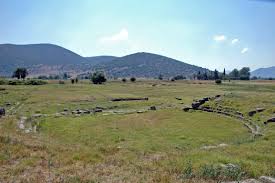 Mantineia was an important Arcadian ancient town, located in the middle of a valley, called “Mantiniki”. In the “agora” area of the ancient city of Mantineia and at a short distance from the ancient theater, there stand the foundations of the temple dedicated to Hera (Pausanias 8, 9, 3). It has a simple architectural form, belonging to the “distyle in antis” category: two columns between the antae of the façade, on the eastern side. Pausanias describes the cult statue of the goddess, inside the temple, as being sitted on a throne with her divine messenger Hebe and goddess Athena, next to her.
Mantineia was an important Arcadian ancient town, located in the middle of a valley, called “Mantiniki”. In the “agora” area of the ancient city of Mantineia and at a short distance from the ancient theater, there stand the foundations of the temple dedicated to Hera (Pausanias 8, 9, 3). It has a simple architectural form, belonging to the “distyle in antis” category: two columns between the antae of the façade, on the eastern side. Pausanias describes the cult statue of the goddess, inside the temple, as being sitted on a throne with her divine messenger Hebe and goddess Athena, next to her.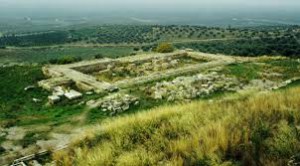 The Argive sanctuary, located between the cities of Argos and Mycenae, was the cult center of Hera “Argeia”, praised by Homer. It was founded in the middle of the 8th century BC. Here, the “Ekatomvaea” festival in honor of Hera, every four years, was mystic, during which the young men and women of Argos were initiated into the age of marriage. The rites started with the parade of the young people, from Argos to the sanctuary, ending with cheerful dances, after the initiation. Hundreds of faithful participants would follow, in order to honor the goddess and watch the rites. The sacrifice of 100 oxen (“ekatomvaea”) and the athletic games would take place together with the re-enactment of the “sacred marriage” of Hera and Zeus symbolized by the adornment of the sacred, bridal bed. The “Ekatomvaea” festival was held in the Heraion, until it was transferred to the town of Argos (3rd century BC) where it was celebrated together with the “Nemea” festival and was renamed “Heraia in Argos”.
The Argive sanctuary, located between the cities of Argos and Mycenae, was the cult center of Hera “Argeia”, praised by Homer. It was founded in the middle of the 8th century BC. Here, the “Ekatomvaea” festival in honor of Hera, every four years, was mystic, during which the young men and women of Argos were initiated into the age of marriage. The rites started with the parade of the young people, from Argos to the sanctuary, ending with cheerful dances, after the initiation. Hundreds of faithful participants would follow, in order to honor the goddess and watch the rites. The sacrifice of 100 oxen (“ekatomvaea”) and the athletic games would take place together with the re-enactment of the “sacred marriage” of Hera and Zeus symbolized by the adornment of the sacred, bridal bed. The “Ekatomvaea” festival was held in the Heraion, until it was transferred to the town of Argos (3rd century BC) where it was celebrated together with the “Nemea” festival and was renamed “Heraia in Argos”.Originally, a prehistorical deity, connected with the wholeness of Nature, was worshipped in the area, before she was identified with Hera, in later ages. The Heraion sanctuary is built on three terraces, on the southwestern slope of a hill, in the Argolis peninsula, offering excellent views towards the valley of Prosymna, below
 The cult of Hera on the island of Samos goes back to the 2nd millenium BC. Initially, at the very spot of the sanctuary, there was a small open-air, stone altar, with a temple-like shelter, next to it, housing the “xoanon” (cult image) of the goddess. Later, in the 8th century BC, the altar becomes monumental and the first temple of Hera is built next to it. This temple was followed by a bigger one (6th century BC) –a masterpiece of Ionic architecture- which was to be replaced by a “new” temple, built a few years later. Today, we can see the ruins of this 3rd temple, built when one of the seven sages of Antiquity ruled over the island, tyrant Polykrates of Samos. Herodotus has described it as “the largest temple, they had ever seen”. During the Hellenistic age, when the religious feeling gave space to more secular things, the sanctuary became the place of politicians’ self-presentations and political gatherings.
The cult of Hera on the island of Samos goes back to the 2nd millenium BC. Initially, at the very spot of the sanctuary, there was a small open-air, stone altar, with a temple-like shelter, next to it, housing the “xoanon” (cult image) of the goddess. Later, in the 8th century BC, the altar becomes monumental and the first temple of Hera is built next to it. This temple was followed by a bigger one (6th century BC) –a masterpiece of Ionic architecture- which was to be replaced by a “new” temple, built a few years later. Today, we can see the ruins of this 3rd temple, built when one of the seven sages of Antiquity ruled over the island, tyrant Polykrates of Samos. Herodotus has described it as “the largest temple, they had ever seen”. During the Hellenistic age, when the religious feeling gave space to more secular things, the sanctuary became the place of politicians’ self-presentations and political gatherings.The finds of the excavations at the Heraion reflect the fame of the sanctuary which was worldwide: ancient visitors from all parts of the world (Egypt, Syria, Assyria, Babylon, Mesopotamia, Persia, Phoenicia, mainland of Greece, Crete, Cyprus) would visit the sanctuary bringing their exquisite offerings for the goddess.
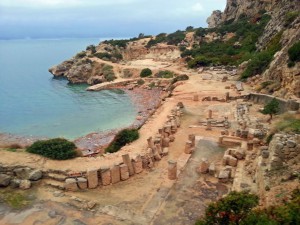 At a short distance from the town of “Korinthos”, just 15 kilometers northwest of the ancient city and at the tip of the Perachora peninsula, the remains of the Heraion sanctuary offer great views towards the Corinthian bay and the modern Corinth canal. Here, at the very site of the sanctuary of Hera, important traces of the early Corinthian civilization have been discovered, together with traces of the Corinthian rural open-air cult. It was here that Hera was worshipped with her two aspects, in two temples: as “akraia” (of the heights) with chthonian characteristics and as “limenia” (of the harbors and waters).
At a short distance from the town of “Korinthos”, just 15 kilometers northwest of the ancient city and at the tip of the Perachora peninsula, the remains of the Heraion sanctuary offer great views towards the Corinthian bay and the modern Corinth canal. Here, at the very site of the sanctuary of Hera, important traces of the early Corinthian civilization have been discovered, together with traces of the Corinthian rural open-air cult. It was here that Hera was worshipped with her two aspects, in two temples: as “akraia” (of the heights) with chthonian characteristics and as “limenia” (of the harbors and waters).The excavations have reached the near-by lake of Vouliagmeni, where traces of the Neolithic era and the Mycenaean age have been revealed. Most probably, this was the greater area of the ancient city which was formed later and was called “Heraion”.
Here is the land where Medea buried her assassinated kids, after abandoning Corinth and also the land of an oracle of Hera, where a seer lived and offered his guidance to the visitors of the sanctuary (Strabo, 1st century AD). Actually, these two events explain the presence of chthonian elements in the cult of Hera “Akraia” here.
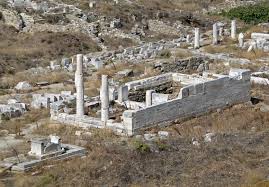 On the sacred island of Delos, on a far higher level than the central sanctuary of Apollo and right at the foot of mountain Kynthos, there stands the temple of Hera. The location of the temple can be explained with regards to its proximity with the temple of Zeus, on the top of Kynthos: the divine couple stands close to each other.
On the sacred island of Delos, on a far higher level than the central sanctuary of Apollo and right at the foot of mountain Kynthos, there stands the temple of Hera. The location of the temple can be explained with regards to its proximity with the temple of Zeus, on the top of Kynthos: the divine couple stands close to each other.This Doric temple of Hera was built in the 5th century BC, over the ruins of an earlier temple of the beginning of the 7th century BC. Thus, excavations have brought to light archaic ceramics, bearing incised dedicatory inscriptions. The temple is “distyle in antis”, with two graceful Doric columns between antae at the façade which was on the southern side. The altar of the goddess stands just across the façade.
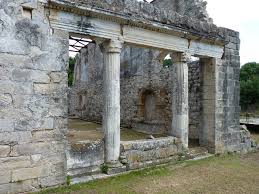 Very close to the modern city of Corfu (at a distance of 3 kilometers), the famous estate houses the “Mon Repos” villa. This neoclassical villa was built by the high commissioner Frederic Adams, in 1830 for his Corfiot wife. The whole estate occupies a part of the ancient city of Kerkyra (Corfu). Here, in the modern times, kings and queens enjoyed hospitality, like the empress of Austria-Hungary Elisabeth, widely known as Sissy and members of other royal dynasties. It was here that the Duke of Edinburg was born, the husband of the Queen of England, Elisabeth.
Very close to the modern city of Corfu (at a distance of 3 kilometers), the famous estate houses the “Mon Repos” villa. This neoclassical villa was built by the high commissioner Frederic Adams, in 1830 for his Corfiot wife. The whole estate occupies a part of the ancient city of Kerkyra (Corfu). Here, in the modern times, kings and queens enjoyed hospitality, like the empress of Austria-Hungary Elisabeth, widely known as Sissy and members of other royal dynasties. It was here that the Duke of Edinburg was born, the husband of the Queen of England, Elisabeth.In the ancient times, there was a sanctuary here, where Hera was worshipped. The traces of her temple are located on the top of the low hill (called “Analepsis”), within the borders of the estate, today. It is an archaic temple, dedicated to Hera “Akraia” (of the heights). Some of its tiles and fragments are exhibited in the Mon Repos Museum. A classical temple (5th century BC) was built over the ruins of the earlier one, of which only a few traces of the foundations have survived.
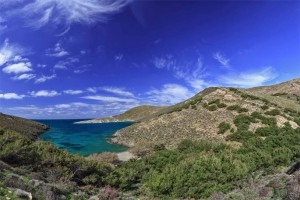 At this point, sailors used to moor their vessels when the weather did not allow them to continue their journey. During such moments they prayed to the gods either to thank them for being rescued from the bad weather, or to plead to them to safely continue their travels. They used to smoothly carve their prayers on the cliffs of the coast while waiting for the right weather conditions that would allow them to take off once again. For this reason the cove was named “Grammata” meaning letters.
At this point, sailors used to moor their vessels when the weather did not allow them to continue their journey. During such moments they prayed to the gods either to thank them for being rescued from the bad weather, or to plead to them to safely continue their travels. They used to smoothly carve their prayers on the cliffs of the coast while waiting for the right weather conditions that would allow them to take off once again. For this reason the cove was named “Grammata” meaning letters.
According to archaeologists the inscriptions date back all the way from the classical antiquity and up to the middle ages.
Source: www.syrosisland.gr
Kastri
- Sep 2,2016
At a distance of about 45 minutes from Chalandriani a prehistoric settlement from the later years of the Early Cycladic period II has been discovered covering an area of 3.5 to 5 acres. In this area the excavations brought to light a graveyard with about 600 tombs as well as ruins of inestimable value that indicate that ceramic, stone and metalwork has been developed in the area. Various vases,... read more
The Aquarium in Kini
- Sep 1,2016
The aquarium in Kini is one of the most popular attractions for both children and adults as it enables visitors to experience the magical marine world of the Aegean Sea and study in depth the marine flora and fauna. The Aquarium boasts an educational character as it invites guests to learn everything there is to know about the sea as well as the sea activities and equipment used in such cases so as to awaken... read more
Pherecydes Cave
- Sep 2,2016
On the road to Ano Syros and shortly after the rural settlement of Kyperoussa one can find the cave of Pherecydes. To reach the cave he must follow a small dirt road that slowly begins to go downhill leading visitors to a magnificent land nuzzled between the earth, the sky and the blue horizon. That’s where the cave where the theogonist poet and philosopher Pherecydes used to reside during the cold... read more
Chalandriani
- Sep 1,2016
Chalandriani is located 9.5 kilometers away from Ermoupolis, on the northeast side of the island and it is one of the most important archaeological sites within the Cyclades as a prehistoric acropolis dating back to the 3rd millennium BC has been discovered in the area after excavations conducted by Christos Tsountas in the late 19th century. Source: www.syrosisland.gr [vc_row][vc_column][ivi_nbcaj... read more
Historic Theater Apollon
- Sep 1,2016
The historic Theater Apollon is one of the major attractions of Syros and constitutes an emblem of the island’s cultural heritage. Created in 1864 by the Italian architect Pietro Sampo who was inspired by 4 stunning Italian standards including the Scala di Milano, the theater Apollon adorns the heart of the capital to this day. The Apollo Theater first opened its doors with an Italian theater troupe... read more
Agathopes Beach
- Sep 1,2016
Agathopes beach is one of the most popular beaches of Syros, just 14 km from Hermoupolis. It is a beautiful beach with golden sand and shallow waters, offering all the comforts as well as easy access by bus making it a perfect choice for a memorable day on the beach. Guests can swim in the clear blue waters and enjoy a coffee or meal in the cafeterias and taverns along the beach. Just 1 km from... read more


